At the beginning of the 2022/23 season, Serie A welcomed a new team—a first-ever participation for AC Monza in the first division.
They earned an 11th-place finish that season under Raffaele Palladino, which was quite impressive in their first campaign.
This season, at the time of writing, they sit 12th under the 39-year-old Italian coach; considering that it is only Monza’s second-ever season in the Serie A, that is a respectable performance.
Palladino’s team has been well-known for their exceptional ability during the build-up phase — almost one of the best teams in Italian football this season!
Our tactical analysis and scout report will provide an analysis of Monza’s style, tactics and ideas during the build-up phase. Let’s start with their game against Napoli.
Napoli vs Monza
In this game, Monza lined up in a 3-4-2-1 shape, a back three of Danilo D’Ambrosio, Roberto Gagliardini and Luca Caldirola—Pedro Pereira as an RWB, along with Patrick Ciurria as an LWB.
A double pivot of Matteo Pessina and Jean-Daniel Akpa Akpro, a narrow two central attacking midfielders, Valentín Carboni and Dany Mota, with a single striker, Lorenzo Colombo.
Napoli‘s 4-3-3 pressing scheme relied on Khvicha Kvaratskhelia pressing D’Ambrosio while covering the shadow of Pereira, Giacomo Raspadori pressing Gagliardini and Alessio Zerbin with Ciurria.
Piotr Zieliński and André-Frank Zambo Anguissa are marking Akpa Akpro and Pessina alongside Stanislav Lobotka, who was the extra man behind the second pressing line from the home side.
Finally, Napoli’s fullback Giovanni Di Lorenzo and Mário Rui are marking Mota and Carboni.
Here, Carboni (highlighted in white) is in a narrow position and dropping to receive in between the lines, with Rui following him.
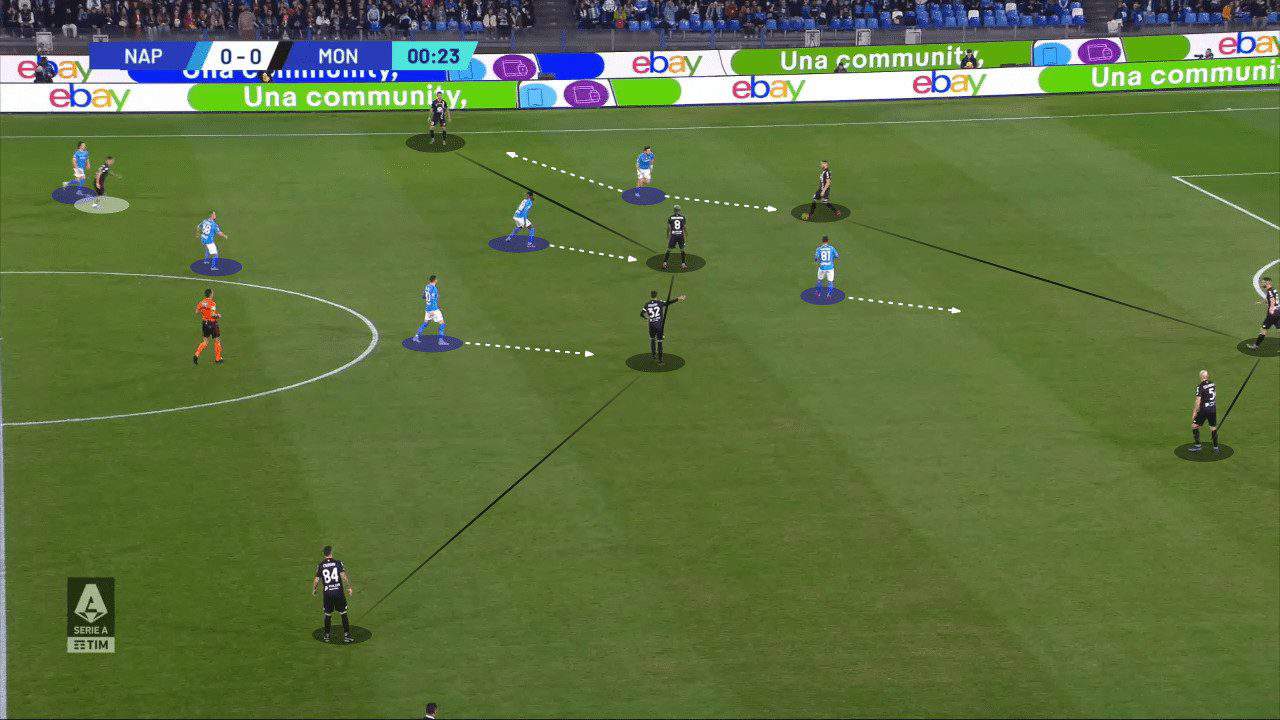
When Carboni received here Lobotka pressed him illustrating the Slovakian’s rule as well we can see the advanced positioning of Ciurria “LWB” dragging Zarbin with him and we can notice how far is he from the rest of the front line.
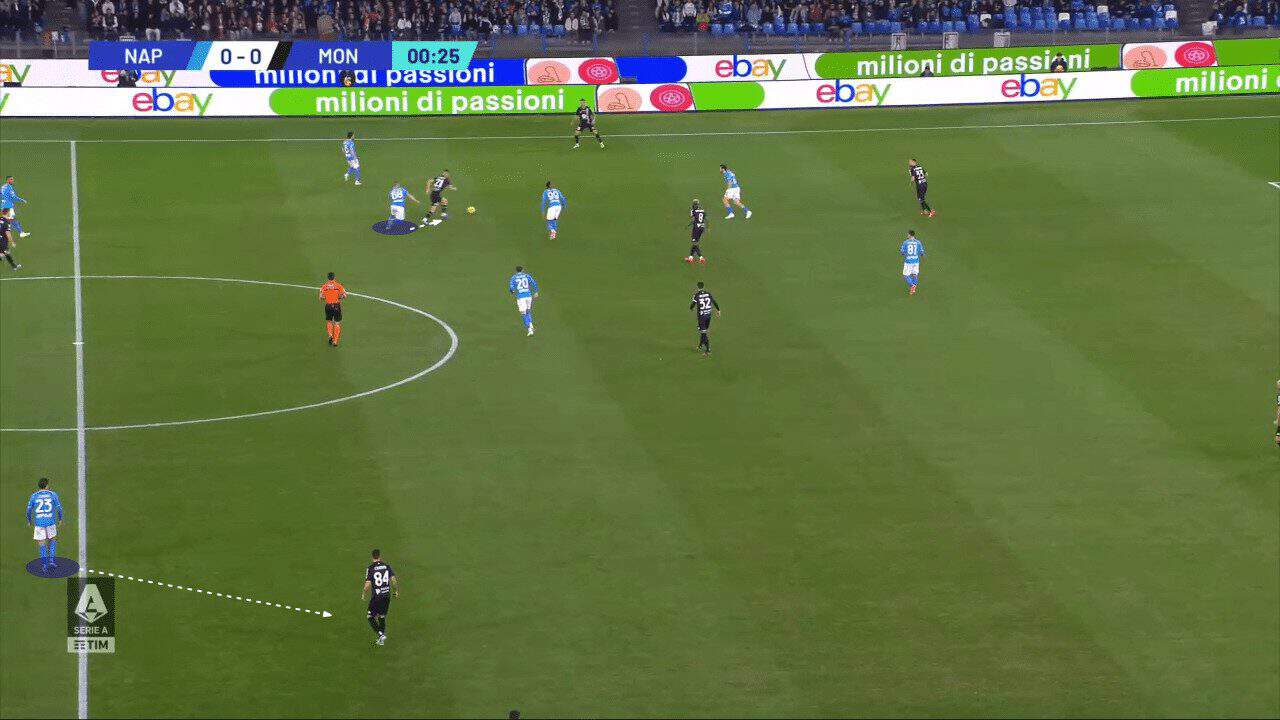
Walter Mazzarri’s high press plan got a 2v3 situation at the back with the advantage to Monza.
Consequently, Here Caldirola can progress with the ball, getting Zieliński in a 2v1 situation also thanks to Ciurria’s higher positioning, which gave Caldirola more time on the ball.
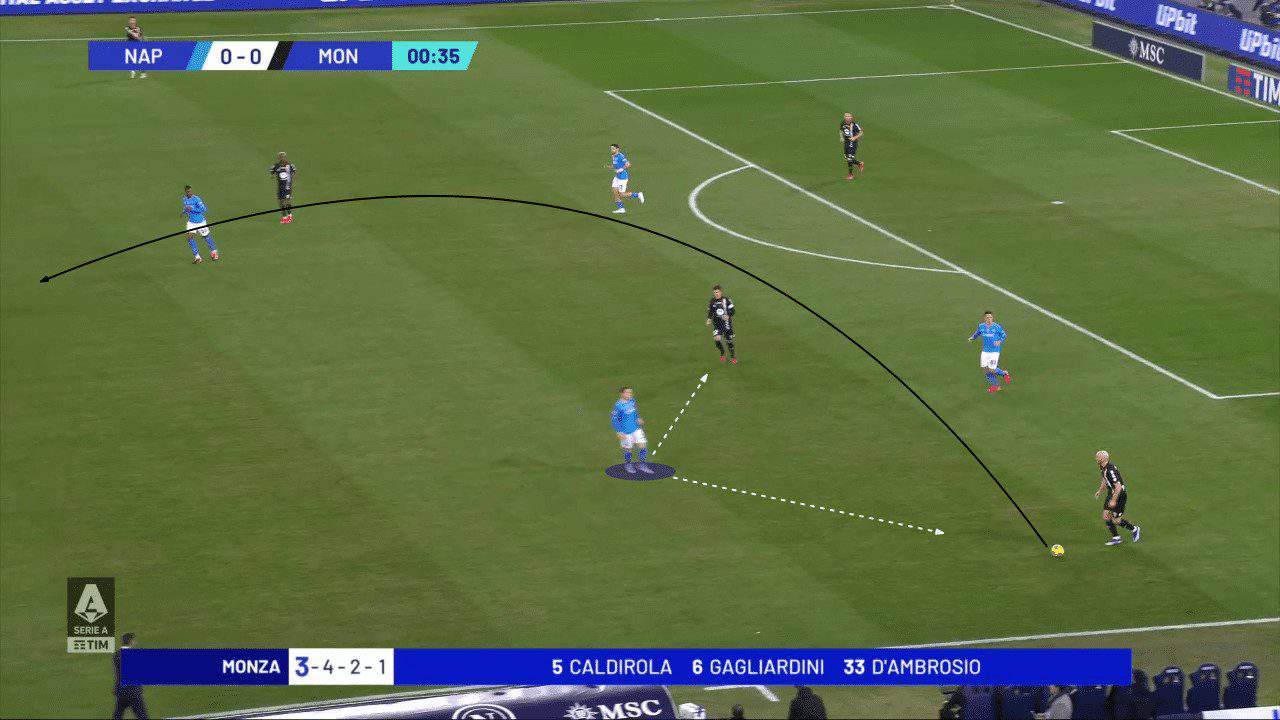
Caldirola’s pass towards the central area, which was evacuated when Lobotka had to drop with Mota, who also dragged Di Lorenzo. With Colombo and Carboni’s narrow positioning, they could utilise this space.
Besides, Zerbin’s position here is almost as a right-back as he had to track back with Ciurria.
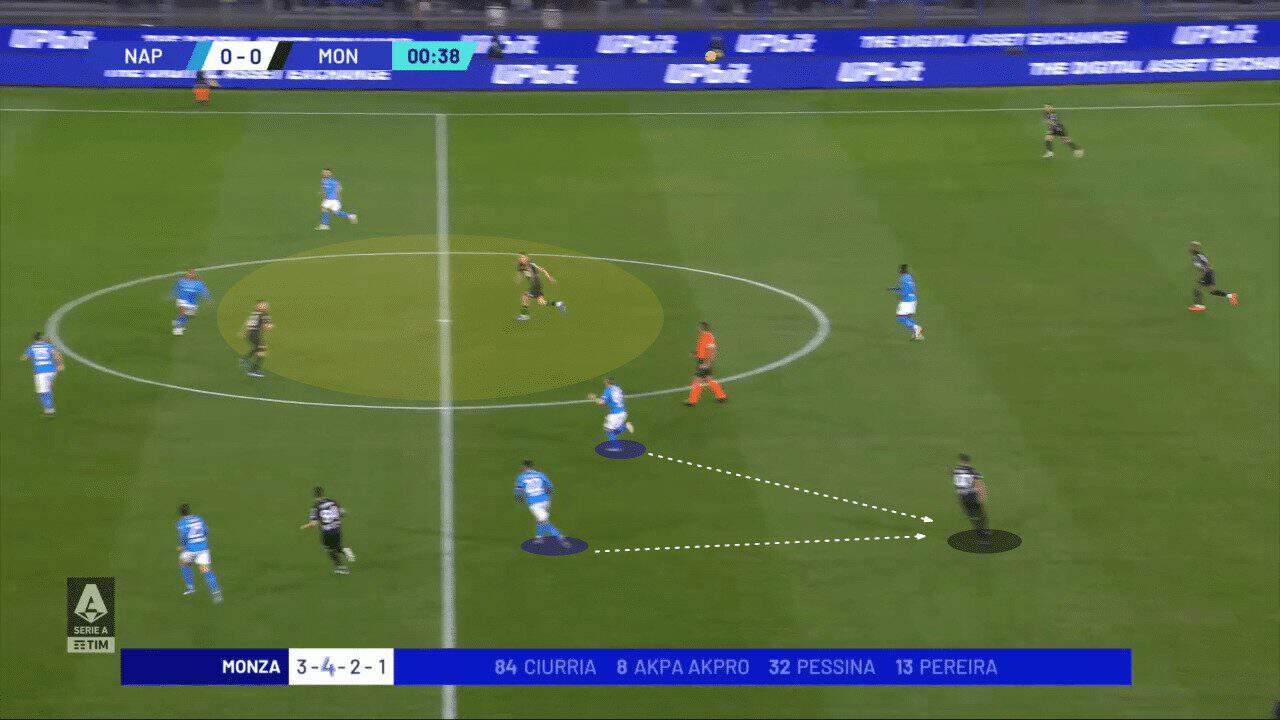
Once again, Zieliński is in a 2v1 situation against Caldirola and Pessina.

Pessina could receive, turn and pass towards Carboni (shadowed), who dropped narrowly with wing-backs (in white) holding the line.

Therefore, Anguissa stepped up to press Caldirola, and Lobotka (in red) switched to press Messina, which facilitated Monza’s intention to evacuate the central area. So, Caldirola will pass centrally again.
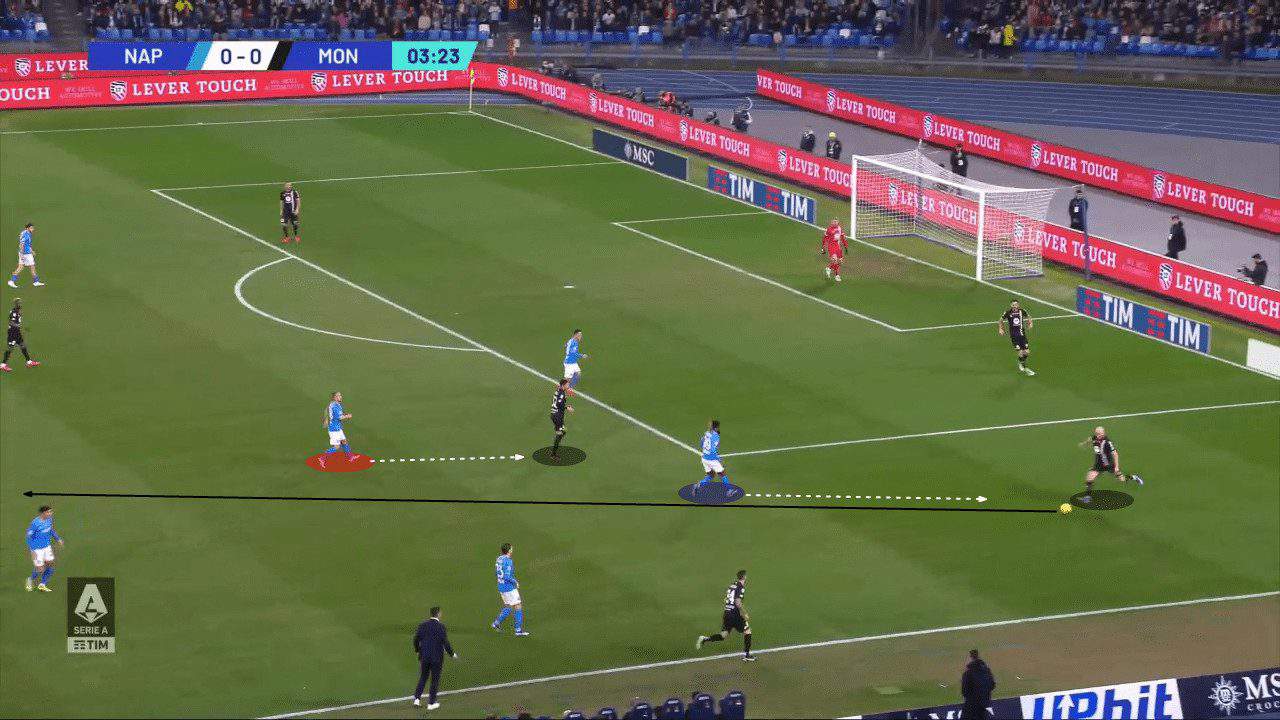
And Colombo received again to break Napoli’s press and notice how he has options to pass and space.
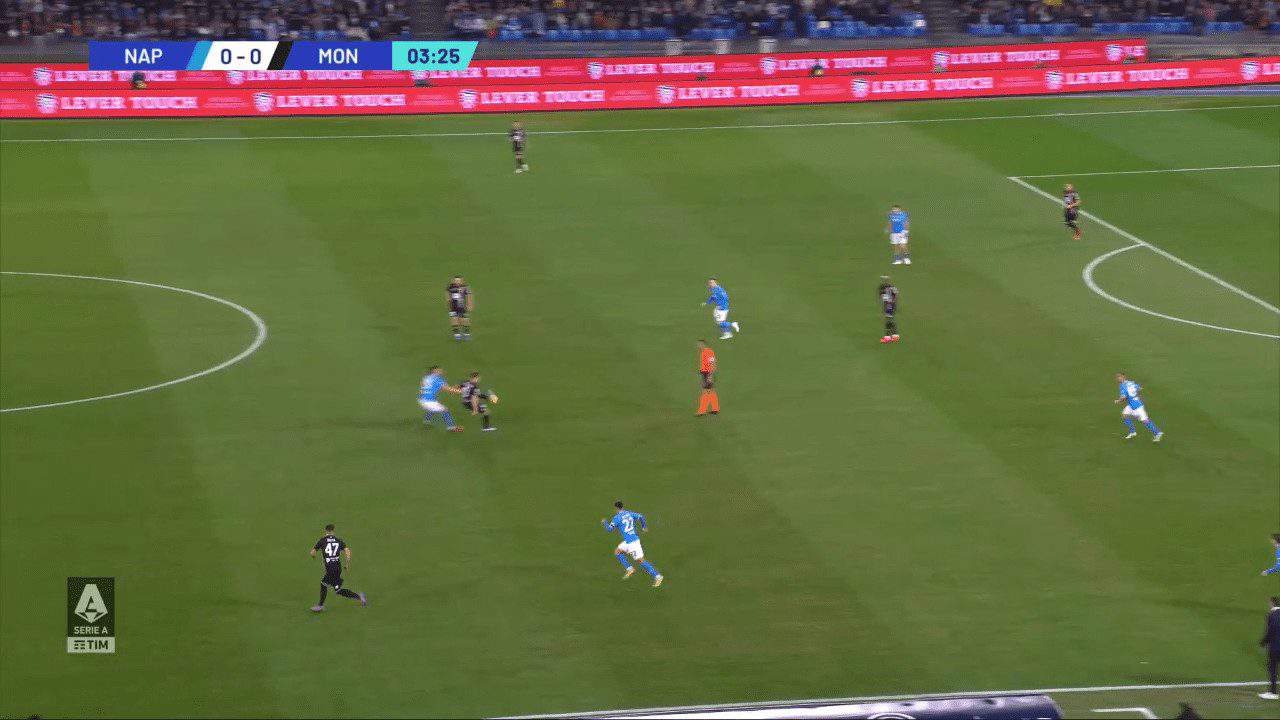
Again, Anguissa is pressing Caldirola with Lobotka dragged towards Pessina but trying to maintain his central position so as not to create a gap behind Napoli’s midfield line.

Caldirola played down the line towards Mota, who switched positions with Ciurria, who became narrow now; with a brilliant flick from the 25-year-old, he could reach Ciurria.
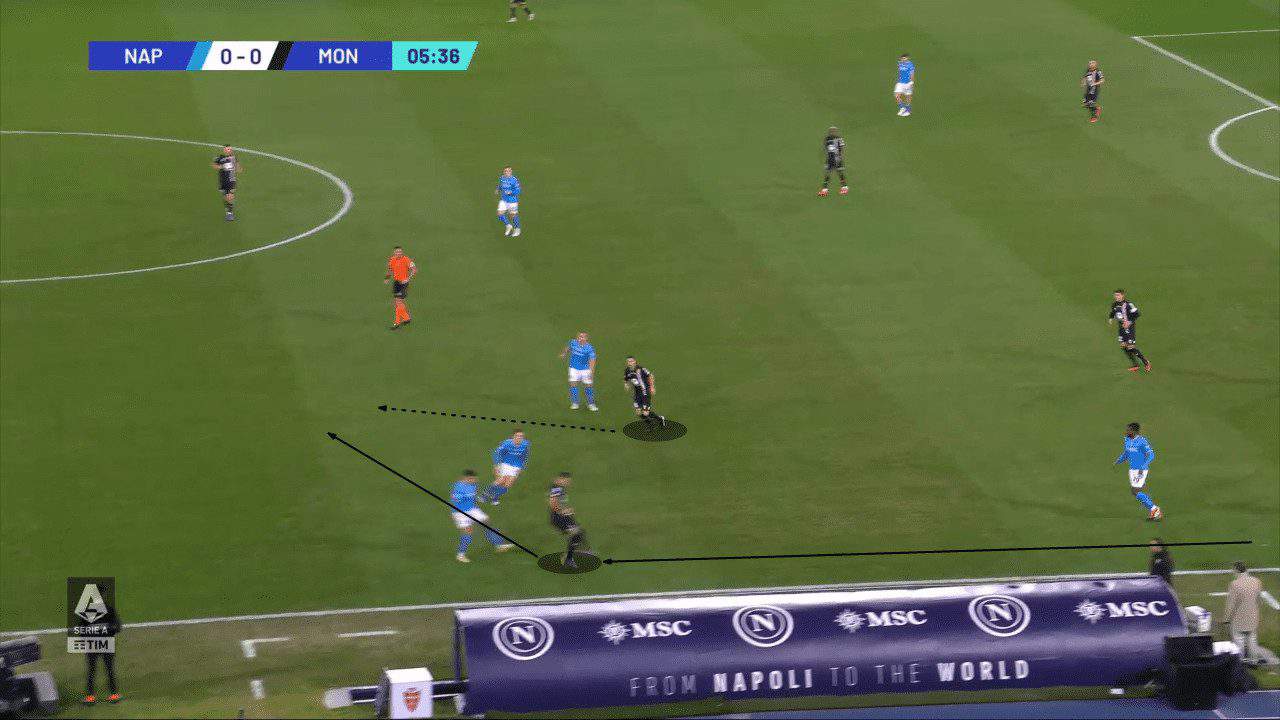
Ciurria had the ball behind Napoli’s midfield, despite Lobotka’s awareness when he decided to try to get back so as not to get stuck with Pessina, but he was still behind Patrick.
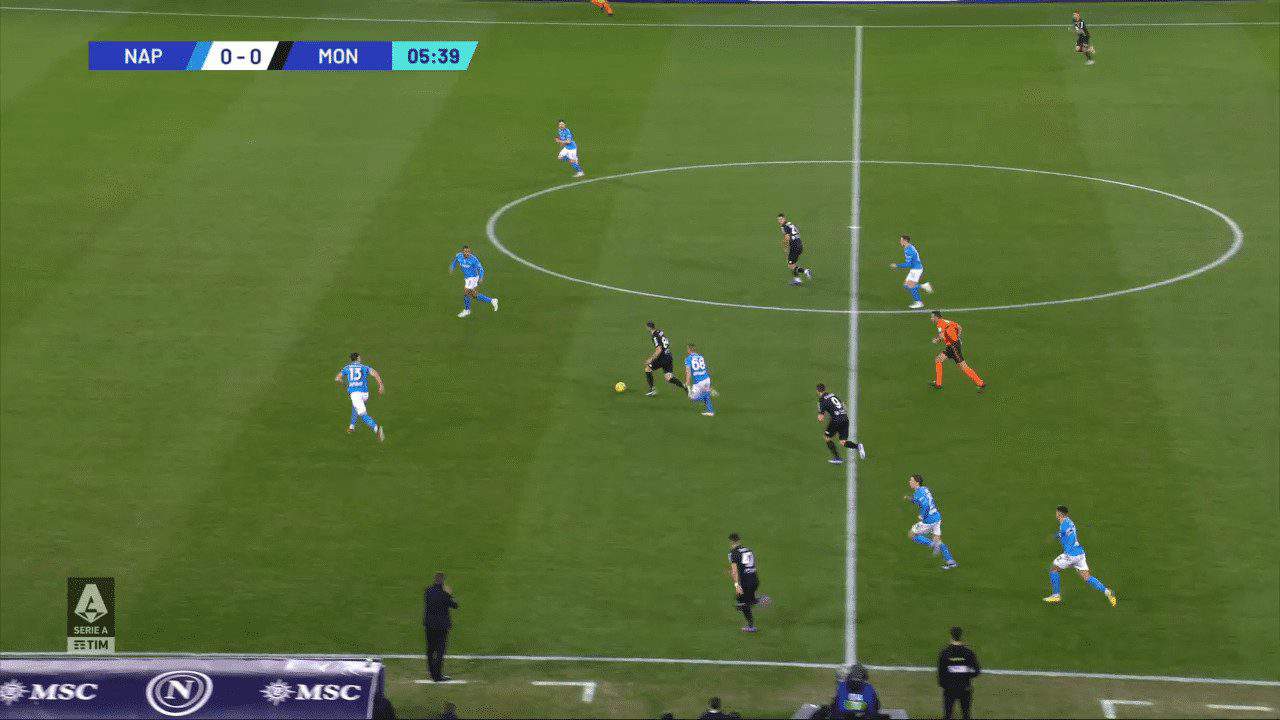
The Blues didn’t have the same problem down their left-hand side as Kvaratskhelia, not the same problem we discussed with Zieliński. However, they suffered on that side also.
D’Ambrosio could pick a pass towards Pereira (shadowed), who escaped Kvaratskhelia cover shadowing smartly and could receive.
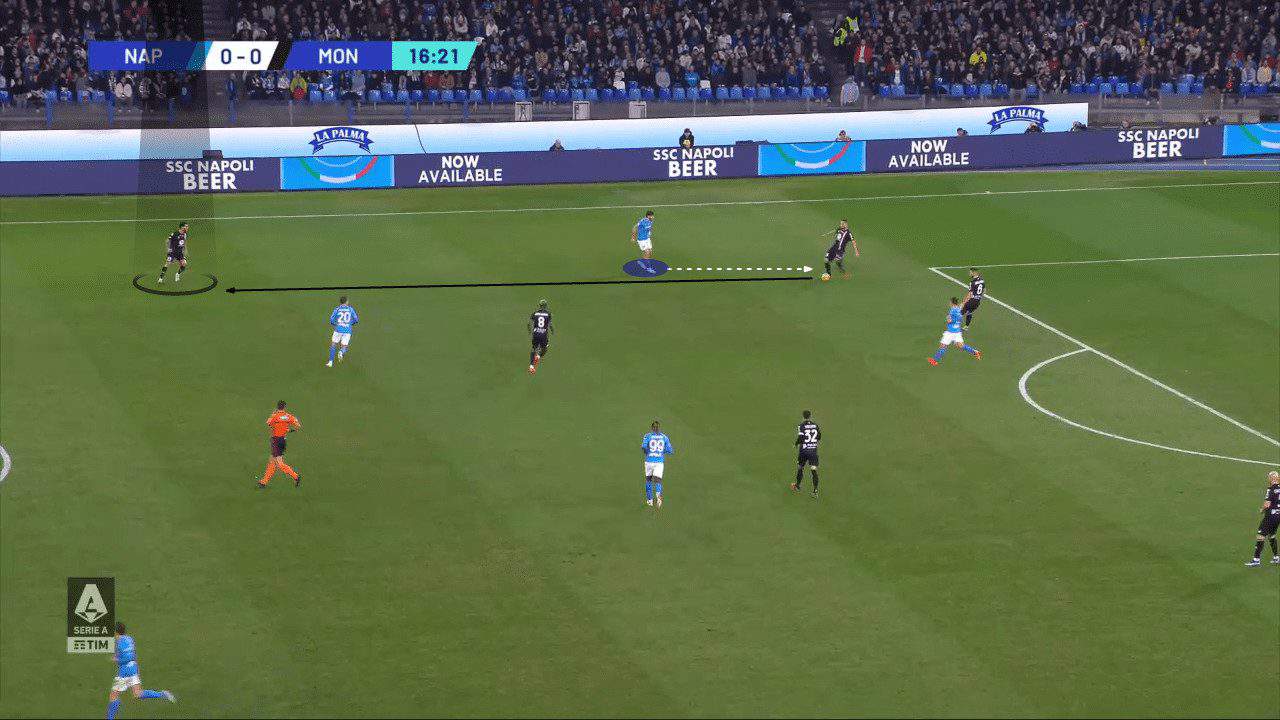
Mario Rui had to step and press Pereira, who found Carboni with a back hill; here, the other attacking midfielder Mota (shadowed) is narrow.
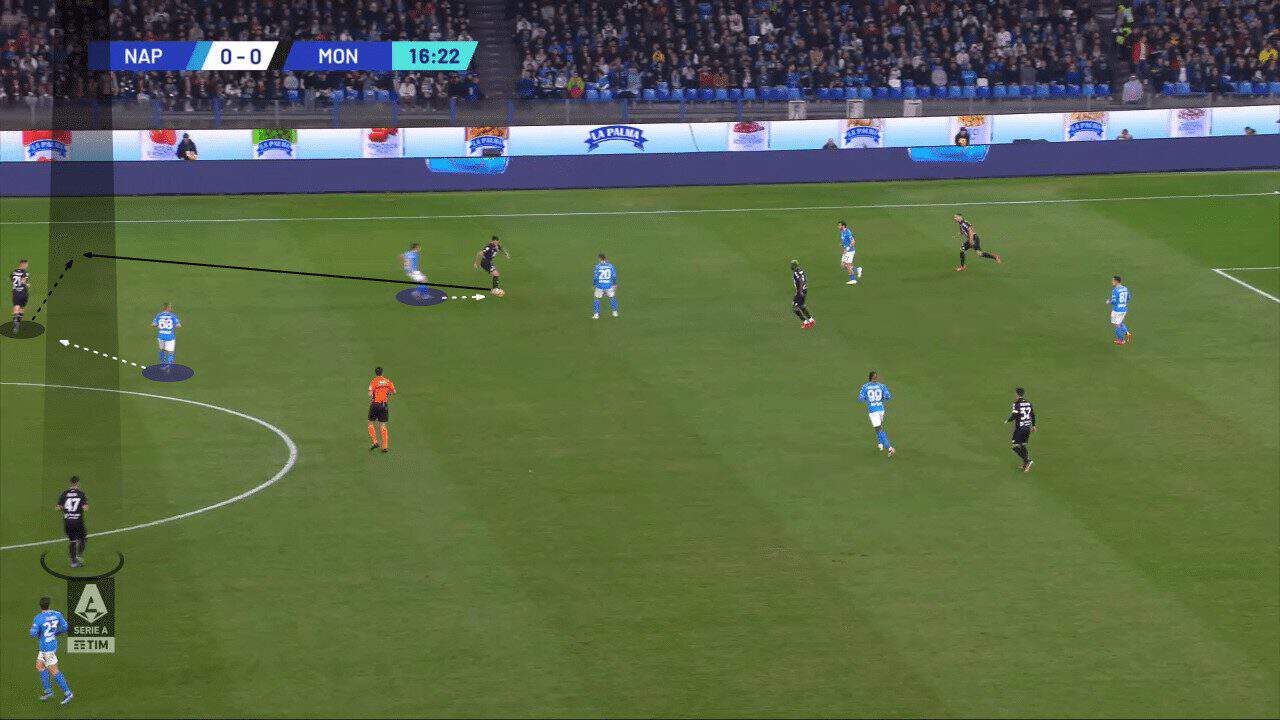
The centre-back Juan Jesus had to press Carboni while Lobotka followed Pereira on Monza’s right flank, and again, a gap centrally was created, which Colombo received.
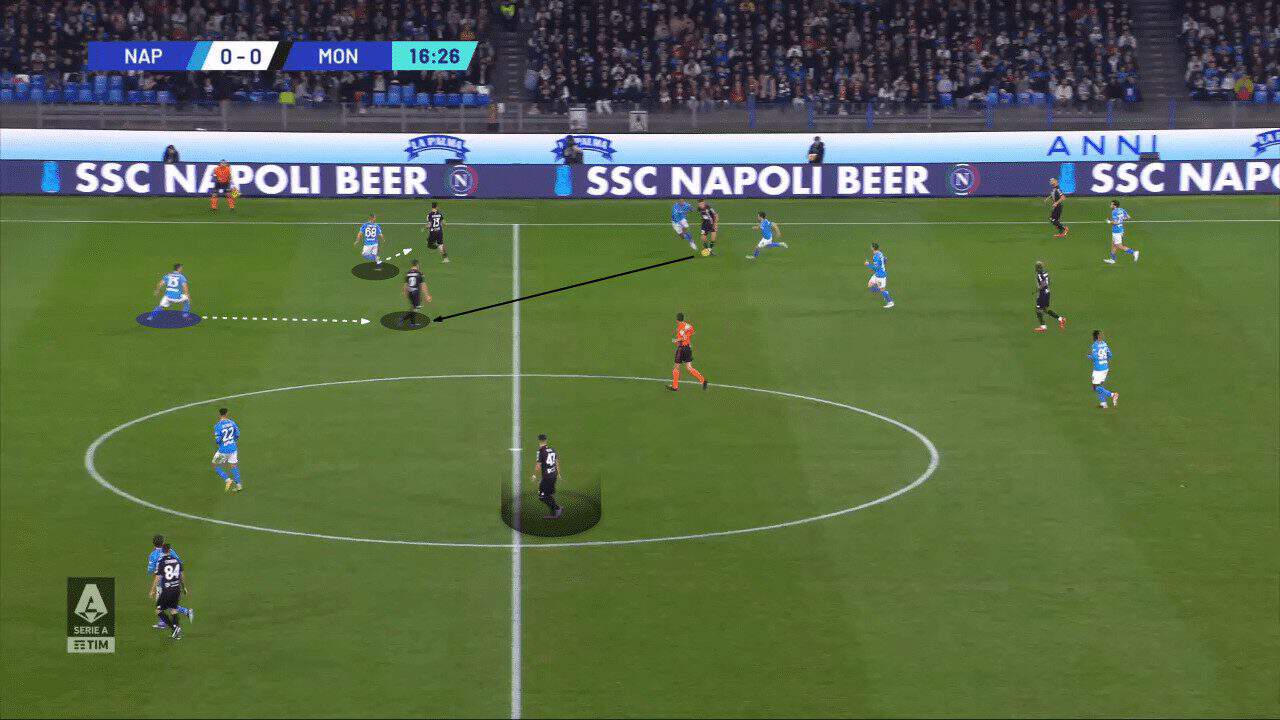
Over and above, on Monza’s right side, Lobotka marked Carboni, and Akpa Akpro played it directly to Colombo.
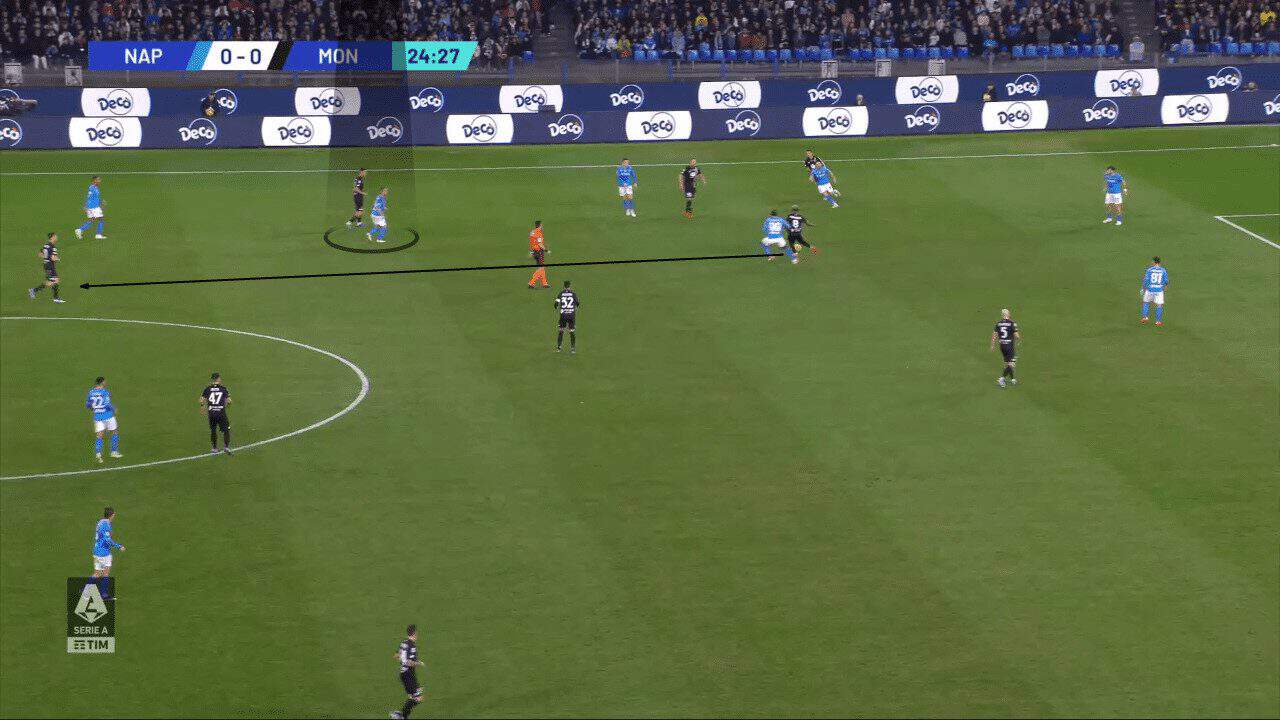
Colombo set the ball for Carboni and observed how many options he had, and the gap was created again.
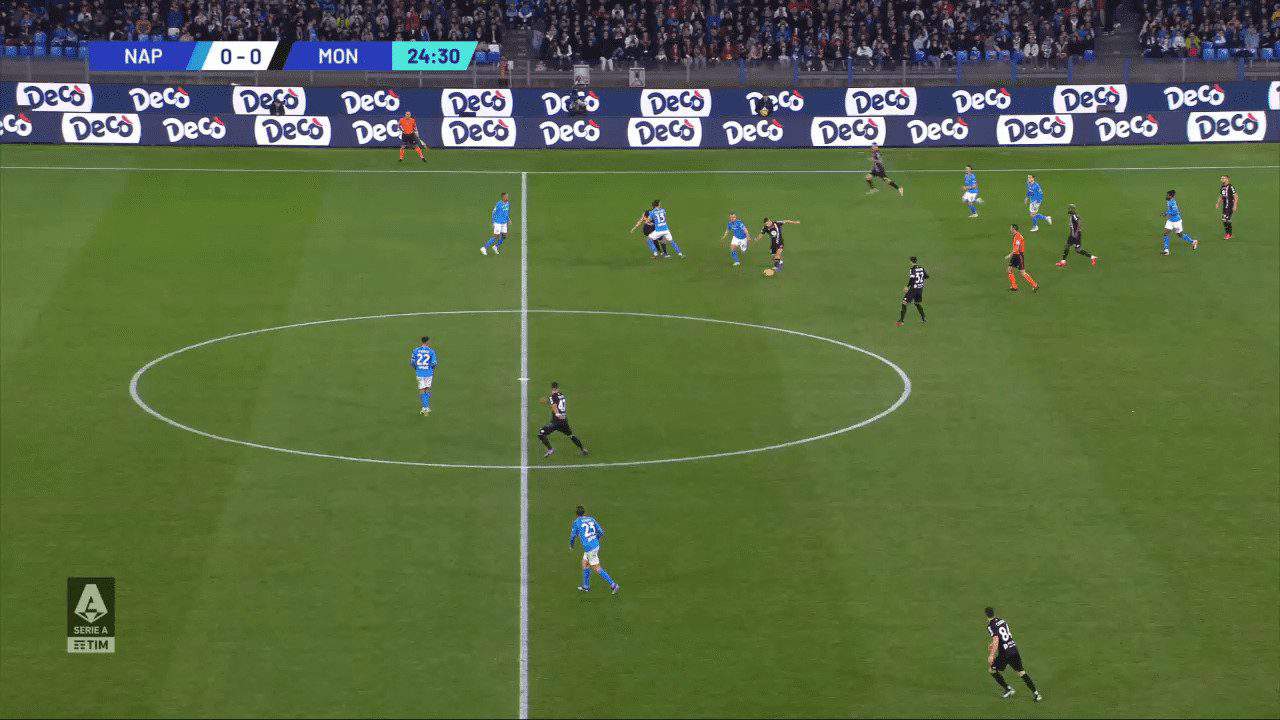
During the second half. Napoli’s right-winger Zarbin (in red) stepped to press Caldirola, leaving Ciurria to be marked by De Lorenzo, and Amir Rrahmani dropped with Mota.
Rrahmani left a space behind him where Ciurria ran into to receive a perfect long ball from Gagliardini behind the defensive line.
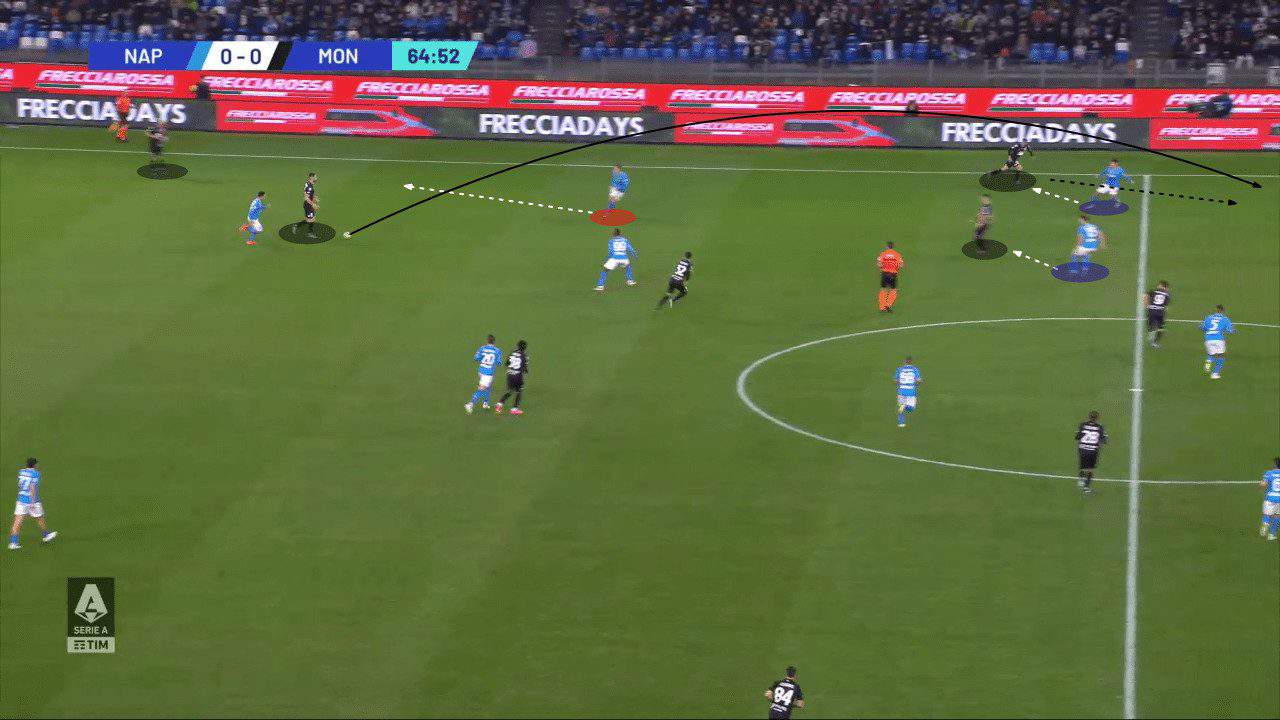
Turns into a dangerous situation and notices how far Rrahmani is.
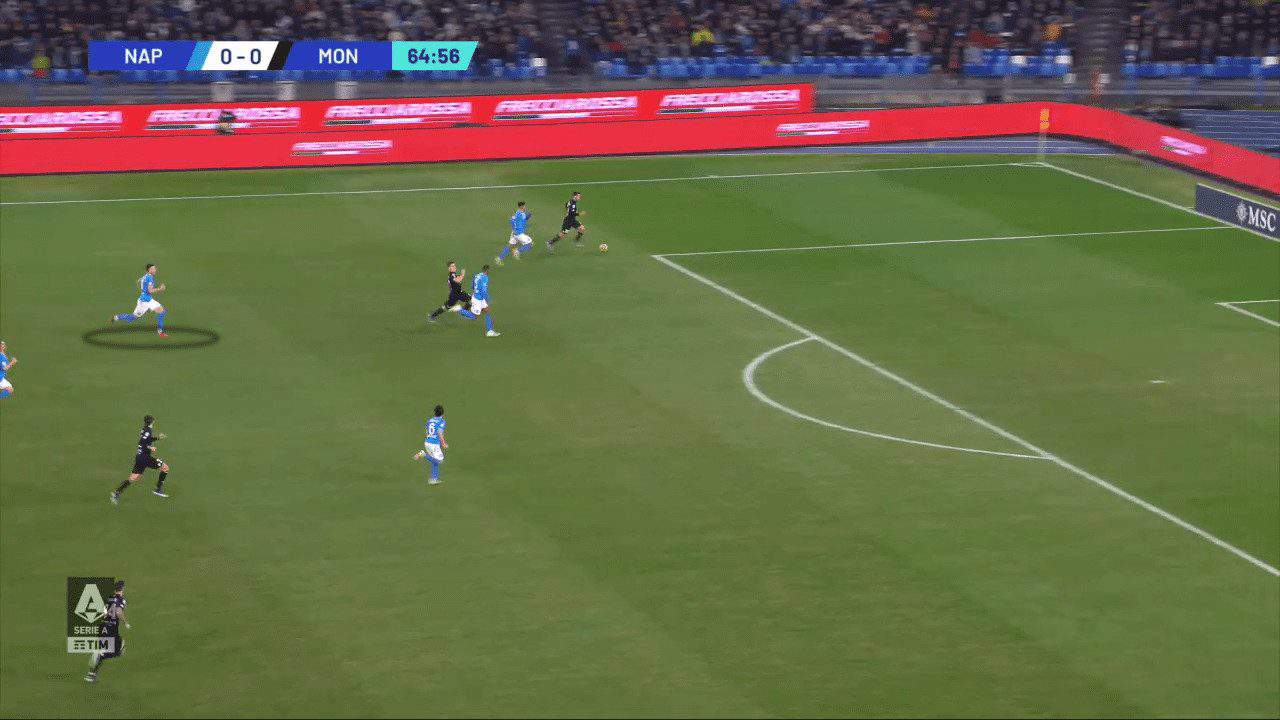
That game showed the quality Monza has during the build-up phase and how they consistently had answers for Napoli’s high pressing, and variation in escaping their press was astonishing.
Monza vs Fiorentina
Fiorentina, under Vincenzo Italiano, is widely known to be one of the top league teams when it comes to high pressing. Eventually, that is a great challenge for I Biancorossi to show their ability during the build-up.
Against a 4-2-3-1 La Viola, Palladino’s side started their game with a 3-5-2 shape, with Giorgos Kyriakopoulos as the left-wing back replaced Ciurria.
Pablo Marí started as the central centre-back, with Gagliardini also joining the midfield, and Andrea Colpani joined Mota for the front two.
The away side high press started from Lucas Beltrán, pressing Marí. The two wingers Christian Kouamé and Jonathan Ikoné were pressing the wide centre-backs. Antonín Barák and Arthur Melo were responsible for Gagliardini and Pessina.
Most importantly, we can see here that Fiortentina’s right-back, Michael Kayode (in red), is stepping forward to press the left wing-back Kyriakopoulos.
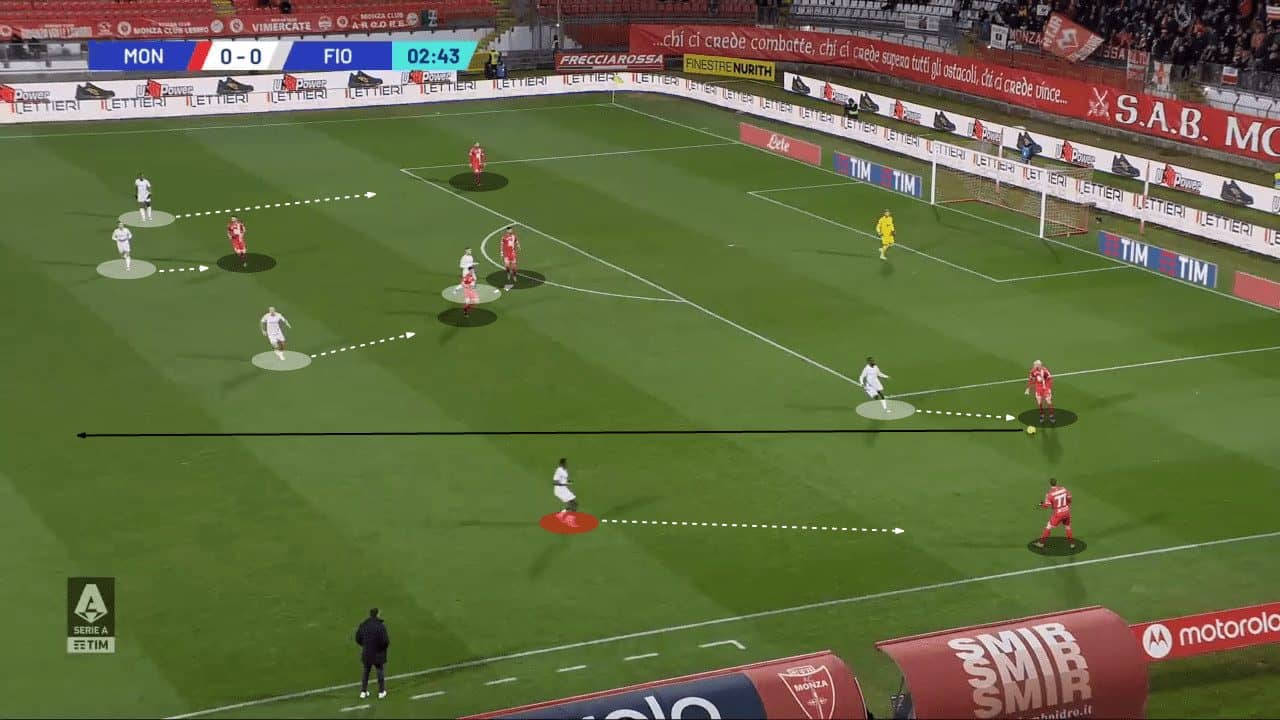
Palladino’s tactical tweak here was through the positioning of Akpa Akpro (shadowed), who moved to the left flank almost as a left winger, dragging the opposition’s midfielder Alfred Duncan (in yellow) with him.
The aim of having the French midfielder here is to evacuate the central space, as we discussed in Napoli’s game, and Caldirola plays a direct pass towards Mota.
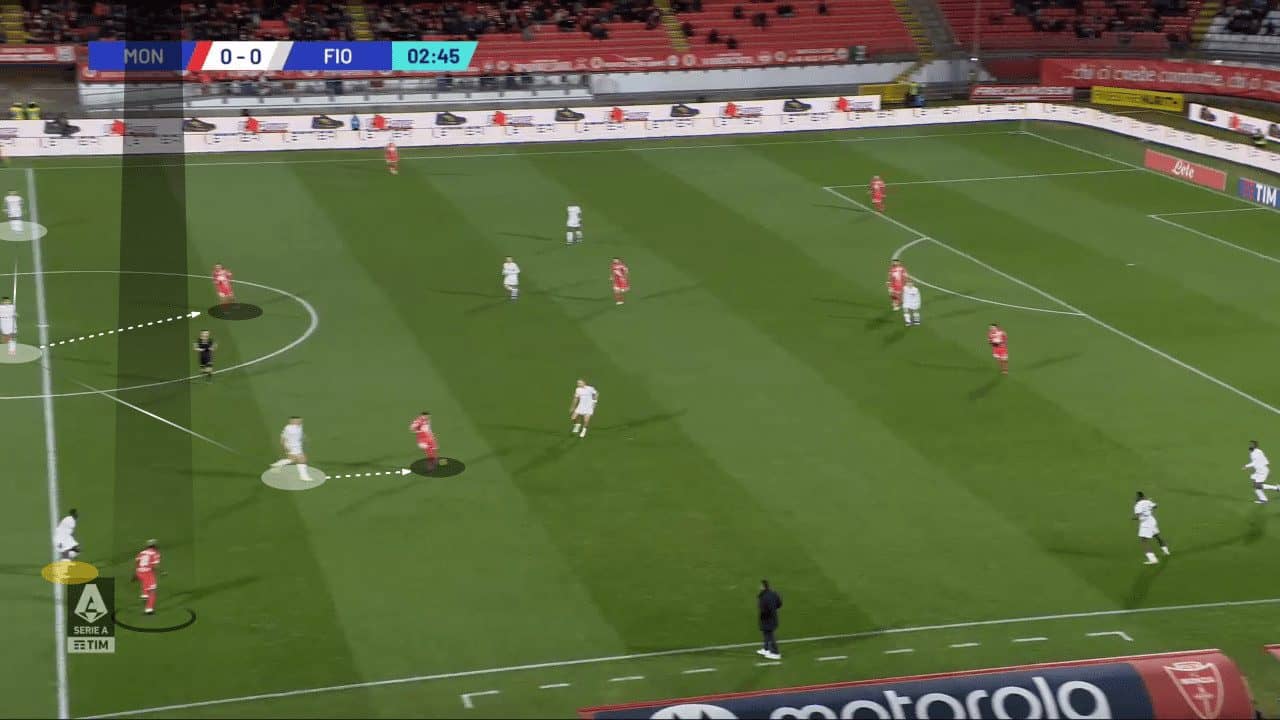
Furthermore, Duncan (in yellow) stayed centrally to avoid creating this gap in his midfield which forces Kayode (in red) to stay back with Akpro (shadowed). At last, Ikoné is in a 2v1 situation against Caldirola and Kyriakopoulos.
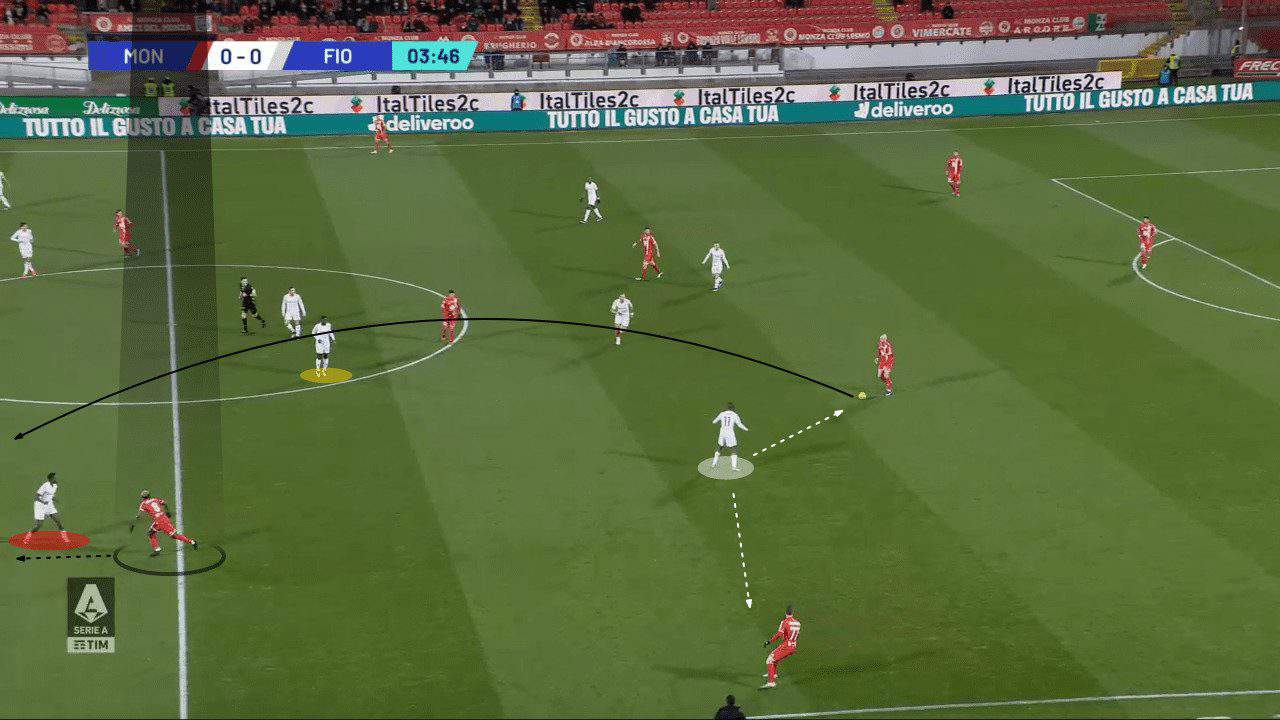
With time and space on the ball, Ikoné hesitates on which one to press, and Caldirola could find Akpro behind the defensive line.
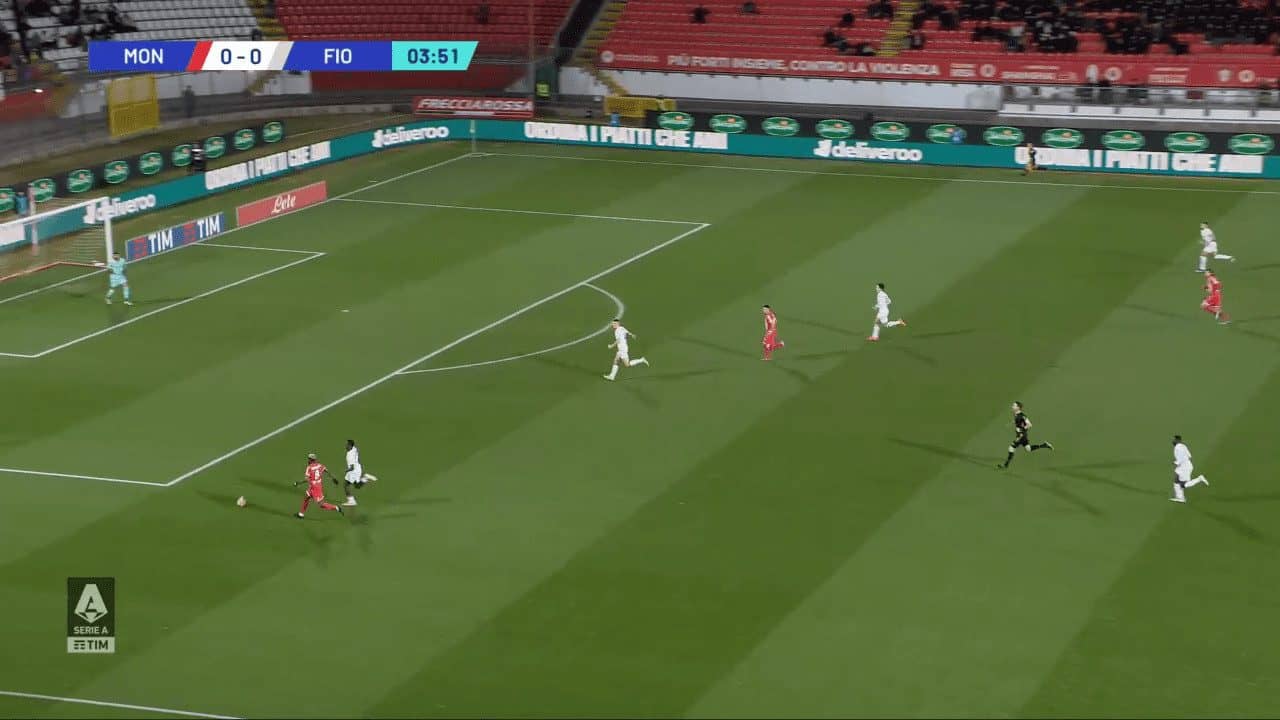
Identically, Akpro is widely positioned and can receive from Caldirola with Ikoné in the same situation.
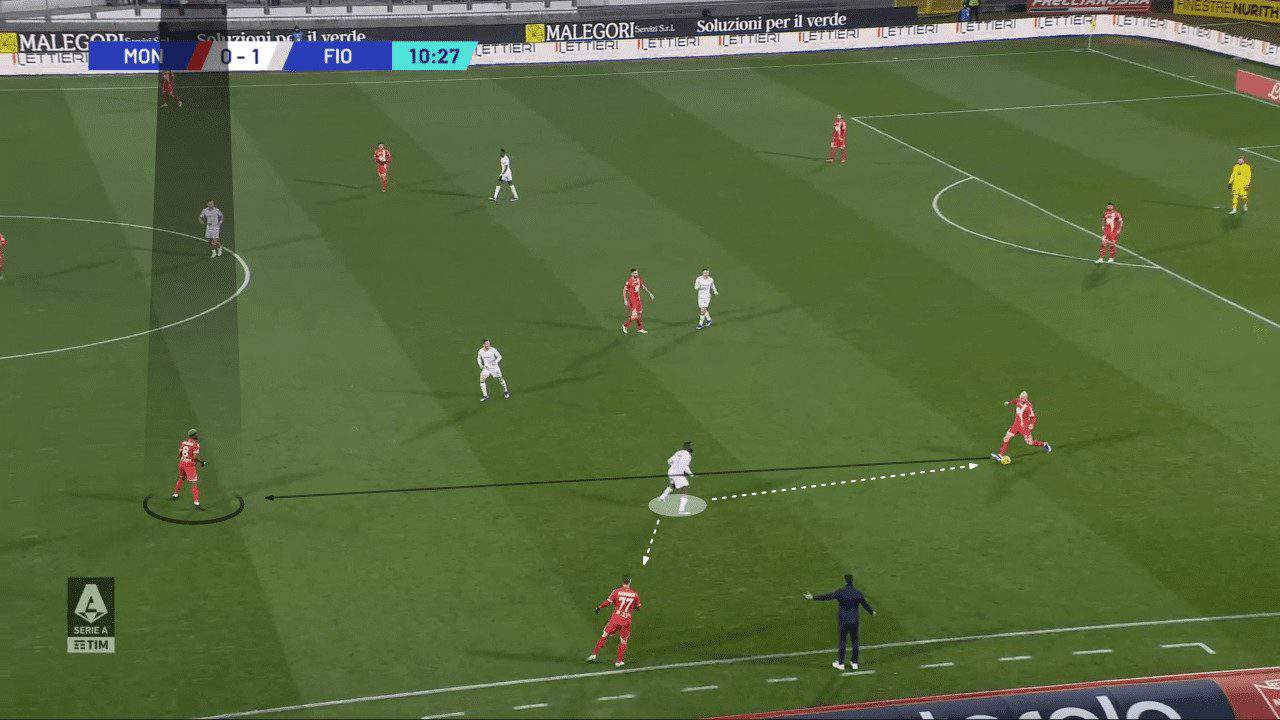
Colpani dropped to receive, dragging Duncan with him and Kayode in the same 2v1, and Monza escaped the press.
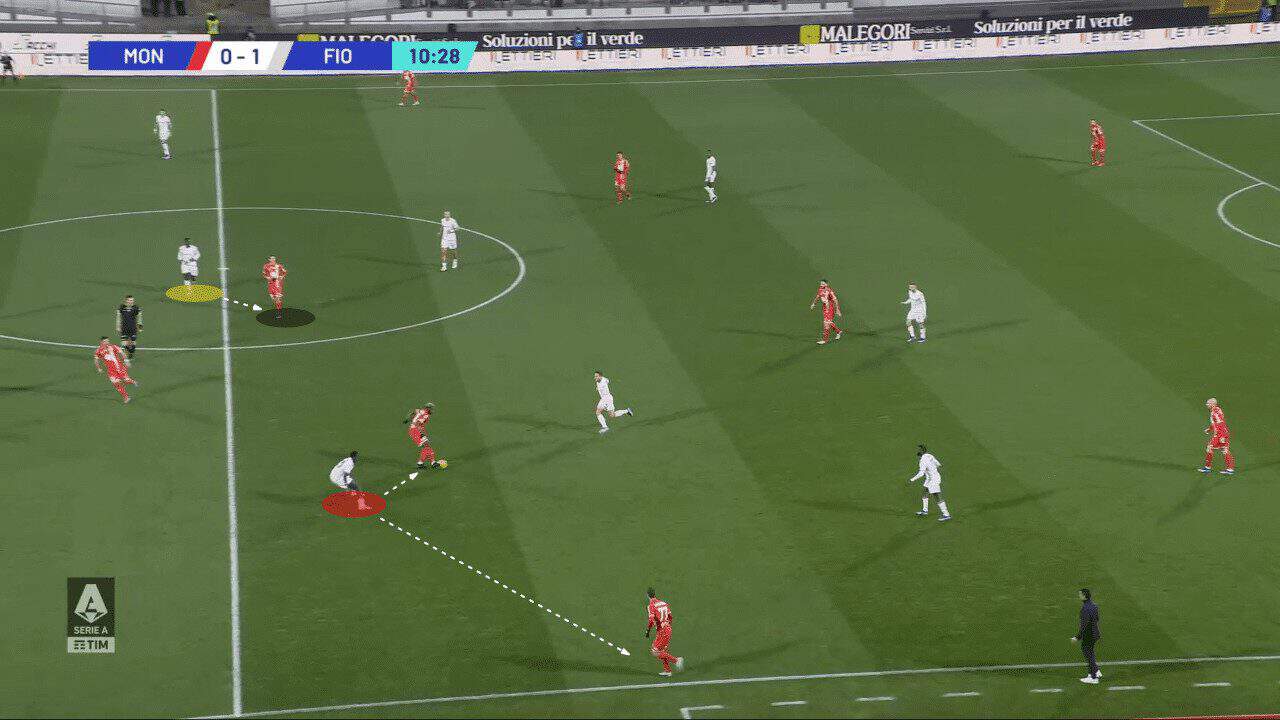
The same obstacle continued for La Viola, and the Greek full-back had a lot of space to receive and carry the ball as Ikoné was dragged by Caldirola.

Duncan had to press Kyriakopoulos, who plays the ball to Akpro.
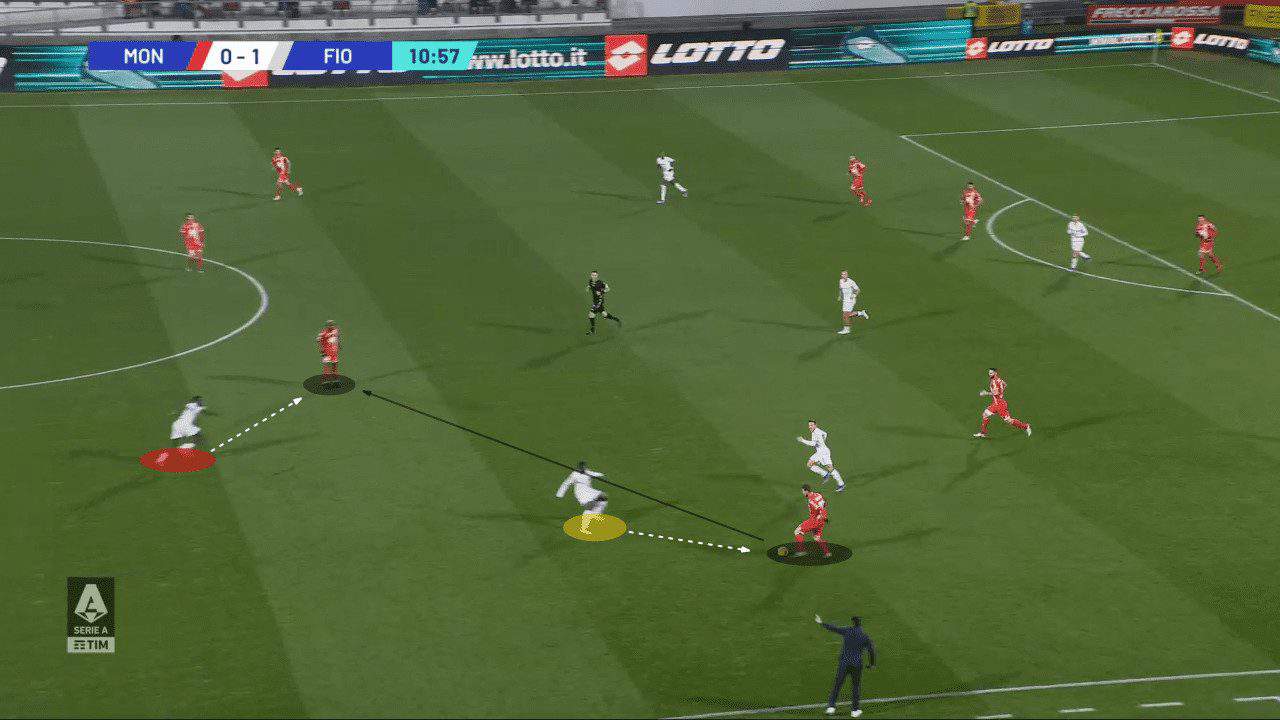
They played a brilliant one-two to take Kayode and Duncan out of the play.
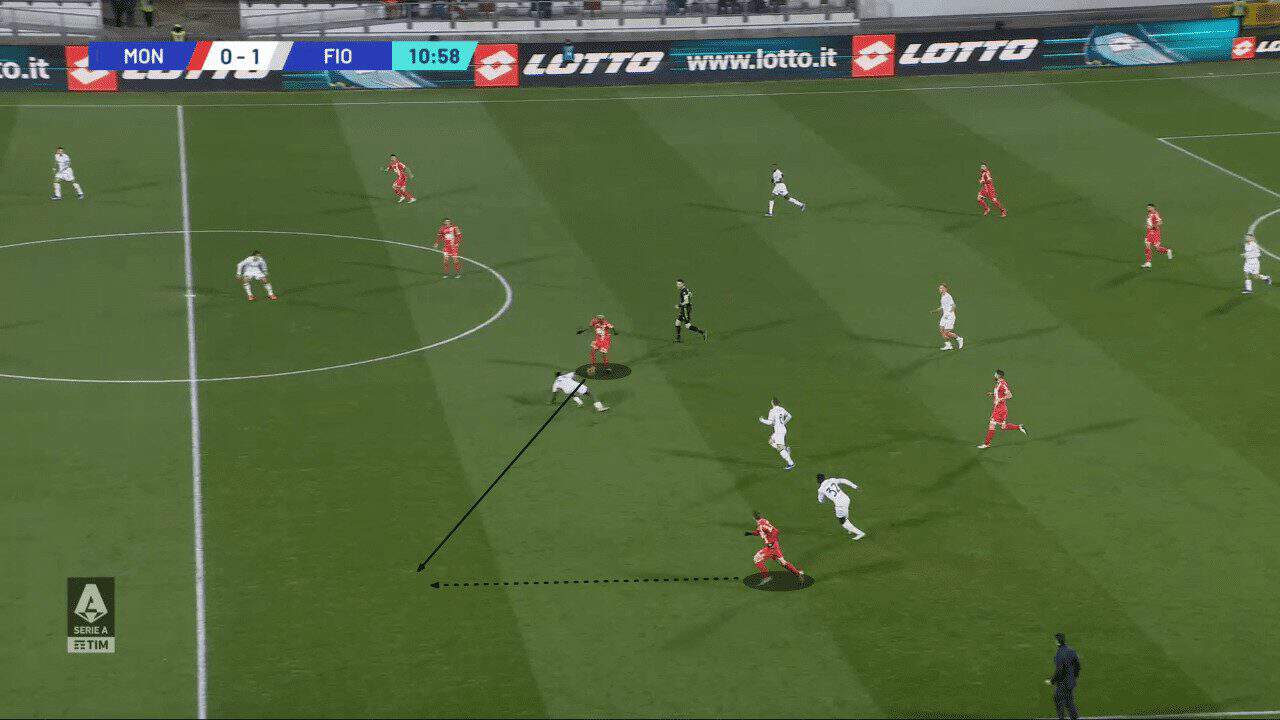
They created a threatening situation with a lot of space for the number 77.
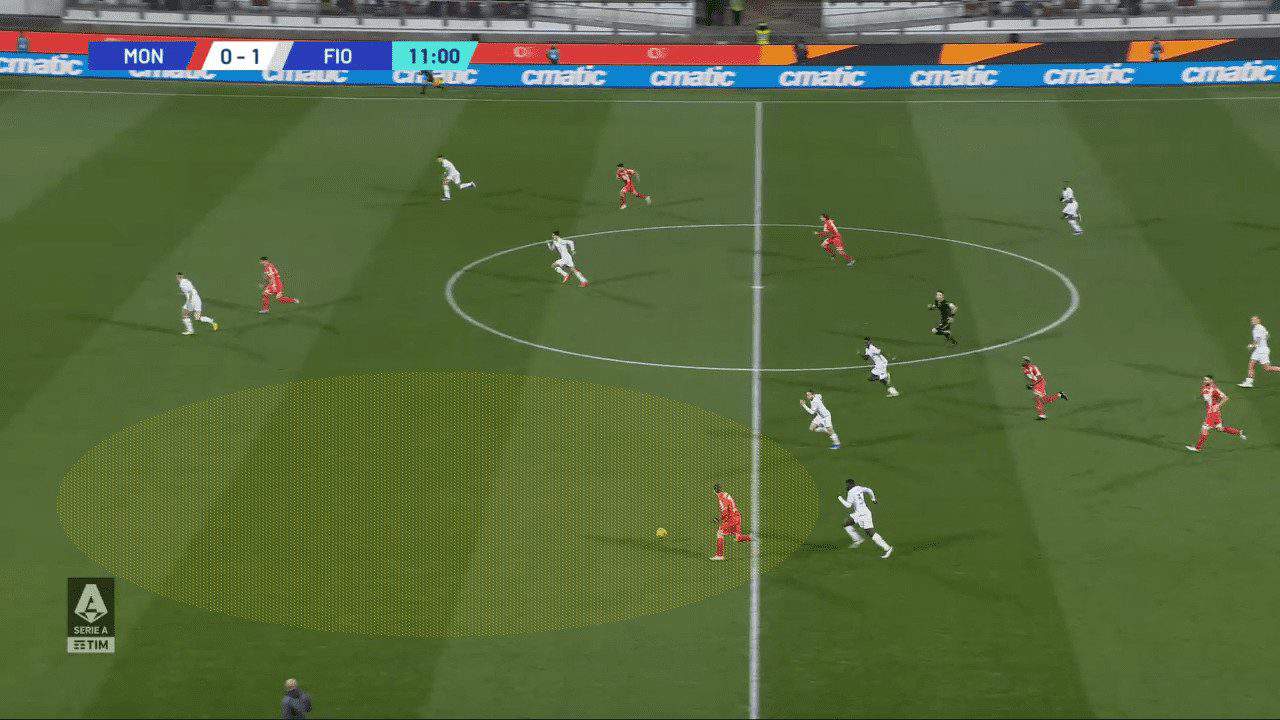
That sequence forced Duncan to press Kyriakopoulos, as shown below.
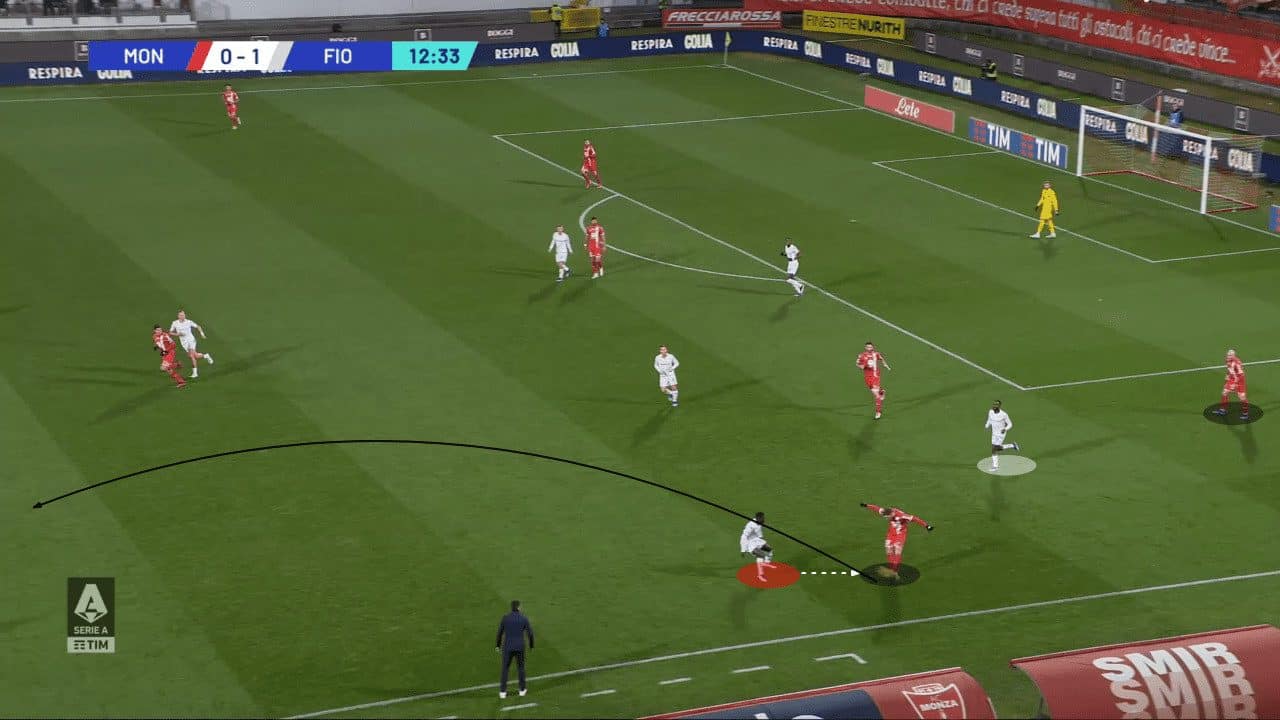
That not only freed up a space deeply in Friorentina’s midfield but also Kyriakopoulos could reach Akpro again with a long ball.
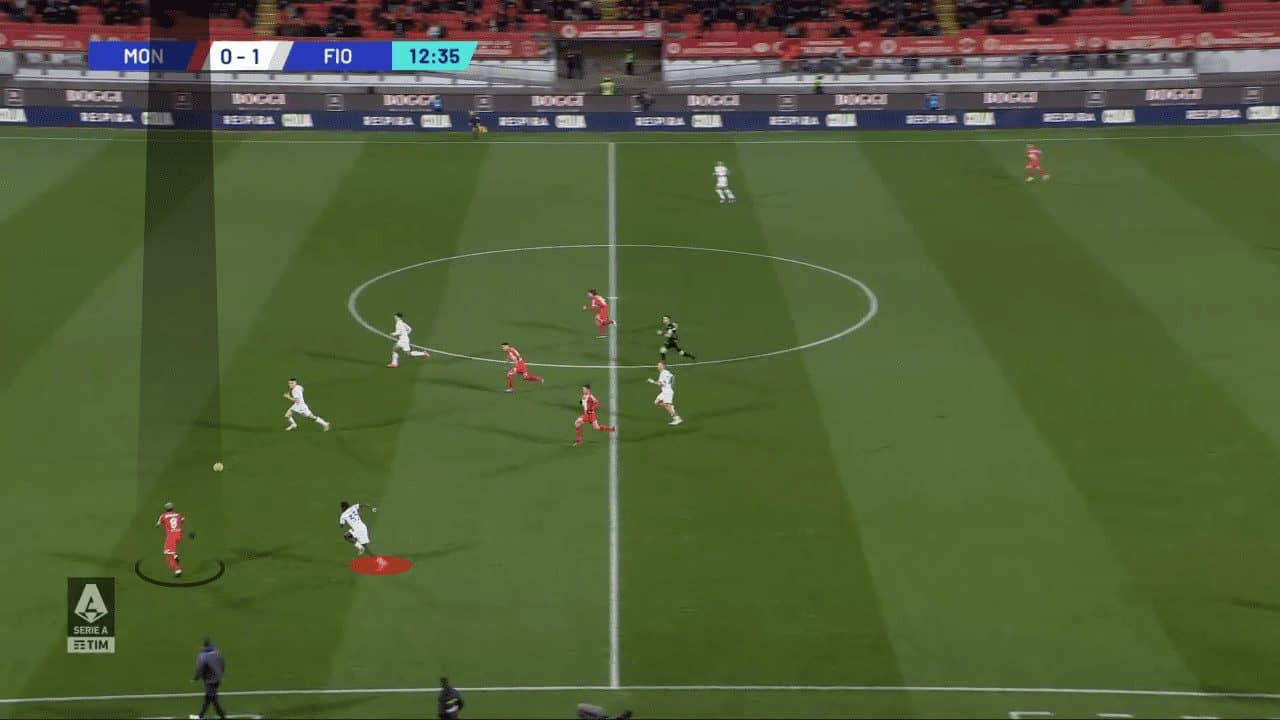
Akpro, with an excellent first touch, set the ball to Colpani and noticed how the midfield was empty with no sign of either Arthur or Duncan.
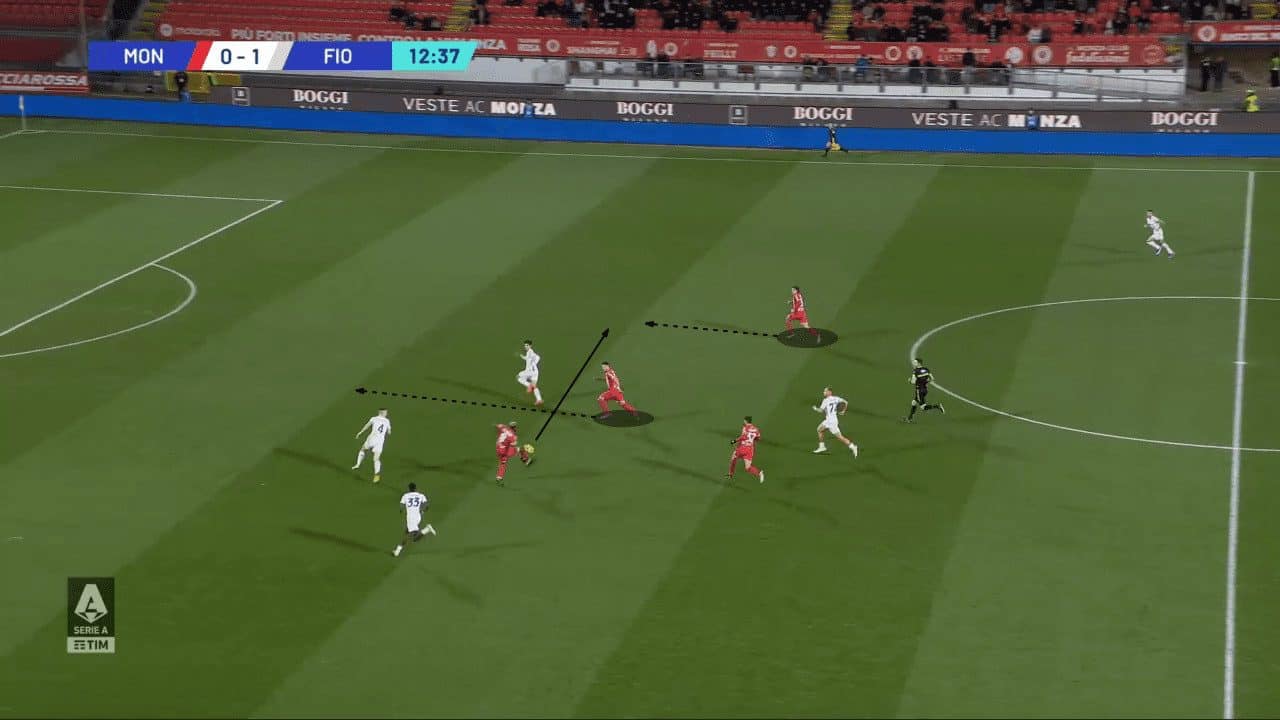
Ikoné is in the same trouble again, and Palladino is pointing towards his Greek player to advance and increase the distance Ikoné should cover.
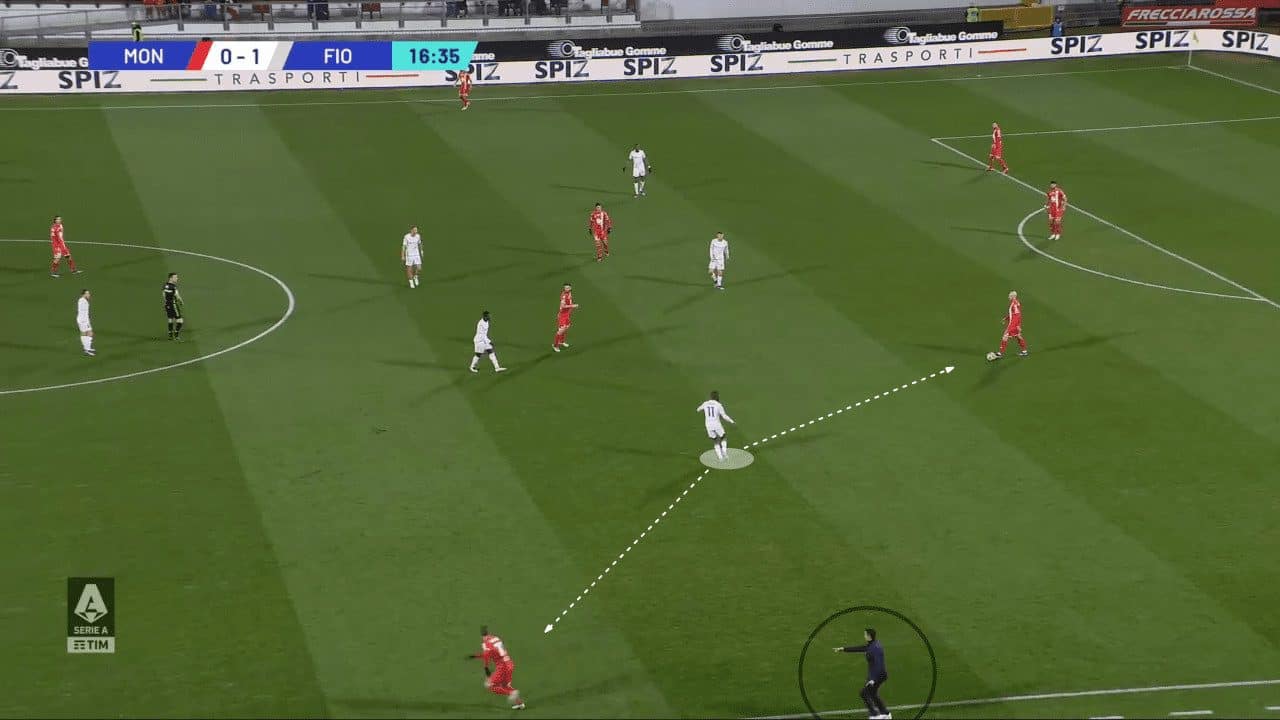
Another idea the home side had is the inverted positioning of Caldirola (shadowed), who dragged Ikone with him and confused Duncan as we can see they are pointing towards each other.

That gave Kyriakopoulos more time to receive and play the long ball down the line for Caldirola.

Here, Mota was the player holding the width, switching his position with Akpro, dropping to drag Kayode with him, and freeing the space for Caldirola to run into.
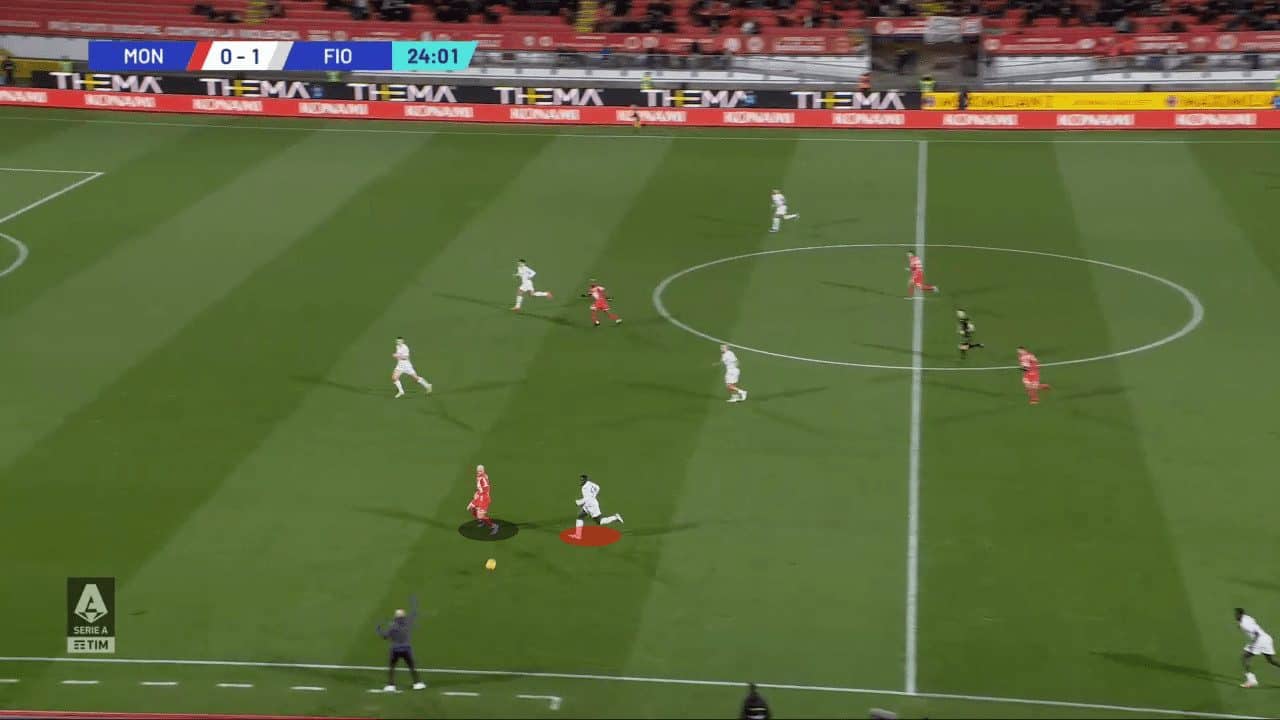
When Duncan marked Akpro (shadowed), it takes us back to the first issue they had, and Caldirola plays a direct pass between the lines.
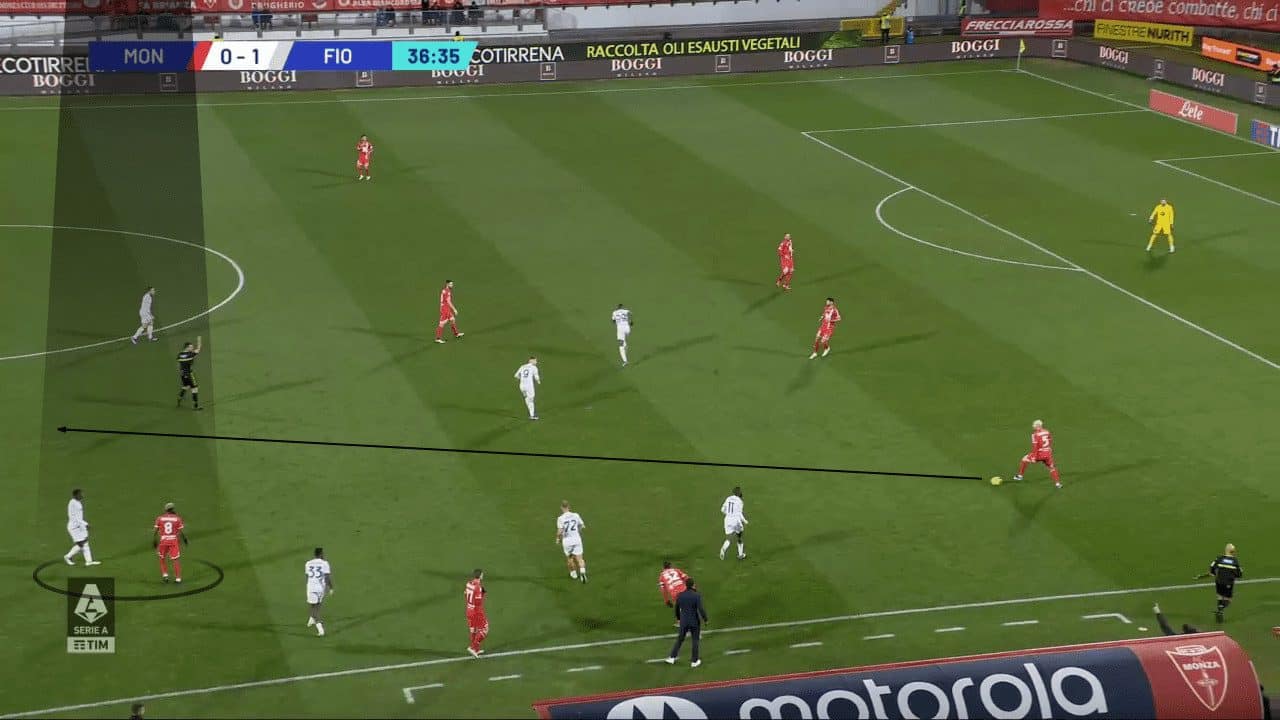
Colpani receives and plays for Akpro in the space behind Duncan, thanks to Kyriakopoulos, who dragged Kayode with him.

Familiarly, Duncan received a good chance to attack at the left flank.
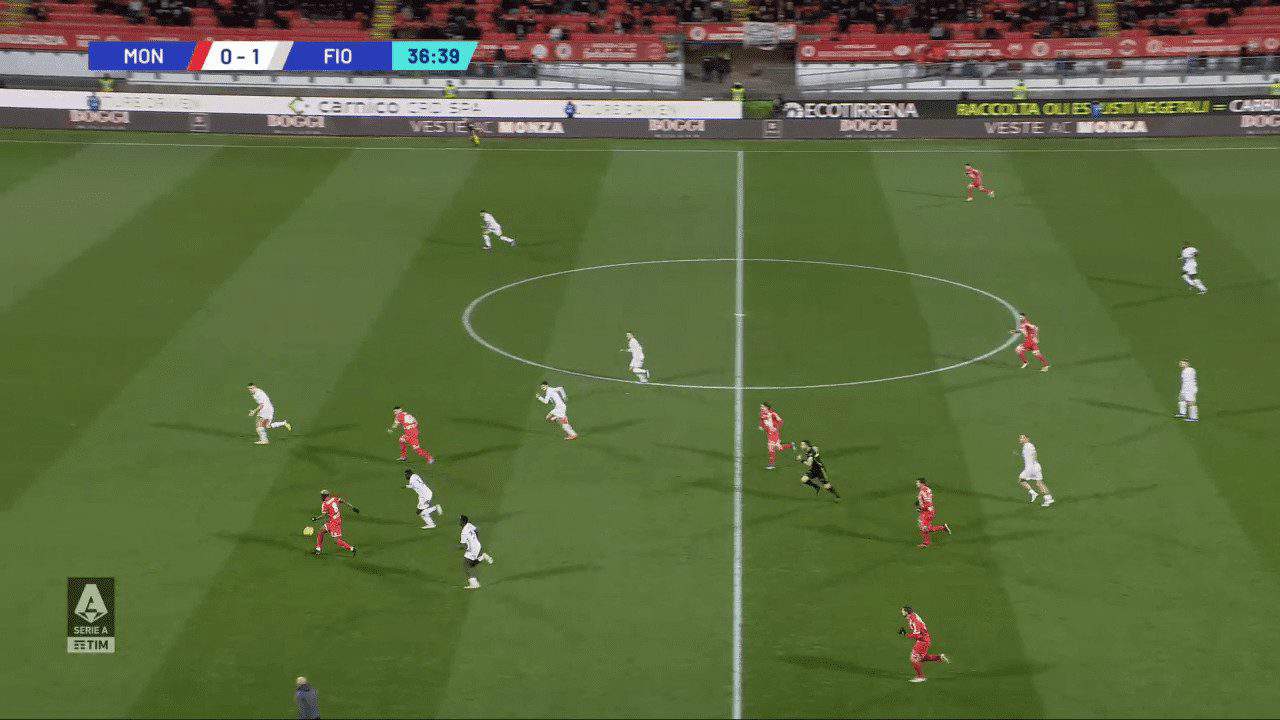
Frosinone vs Monza
Moving on to Stadio Benito Stirpe, the home of Frosinone Calcio, where Monza sealed a 3-2 win. Anyhow, they did suffer during their favourite phase of the game.
Led by the former A.S. Roma coach Eusebio Di Francesco, Frosinone had a 3-4-3 high-pressing shape against the usual 3-4-2-1 from the away side.
The home side relied on a man-oriented approach during high pressing with a little adaptation and succeeded in minimising Monza’s ability on the ball.
The front line of Walid Cheddira, Reinier Jesus and Matías Soulé pressed the opposition’s back three. In addition, the midfield line of four perfectly matches Monza’s midfield.

The little additional idea they had with the man-oriented pressing was when the ball was forced to one side, the winger opposite to the play side here, Soulé (in yellow), moved to press Pessina in the midfield instead of Caldirola to give his teammate Enzo Barrenechea (shadowed) the ability to drop in Monza’s favourite area and be the extra man behind the first two pressing lines.

That highly aggressive man-to-man pressing forced the away side to go long most of the time, which is not what they prefer. Meanwhile, we can see that Soulé is marking Cladirola and Barrenechea with Pessina.

Consequently, that turns into a 3v3 at their backline, a risk but well taken from Di Francesco, and Barrenechea drops again to cover the midfield area.

When the ball was on Monza’s left side, Frosinone’s left winger Reinier moved more in between Warren Bondo, who played in the midfield and D’Ambrosio.

Occasionally, Monza’s only way to escape that pressing scheme was through the long balls in that area here Colpani (shadowed), who was supposed to be on the right side, moved to the other side to receive aided by Mota’s central position to pin both centre-backs.

Again, the goalkeeper Michele Di Gregorio is forced to go long.
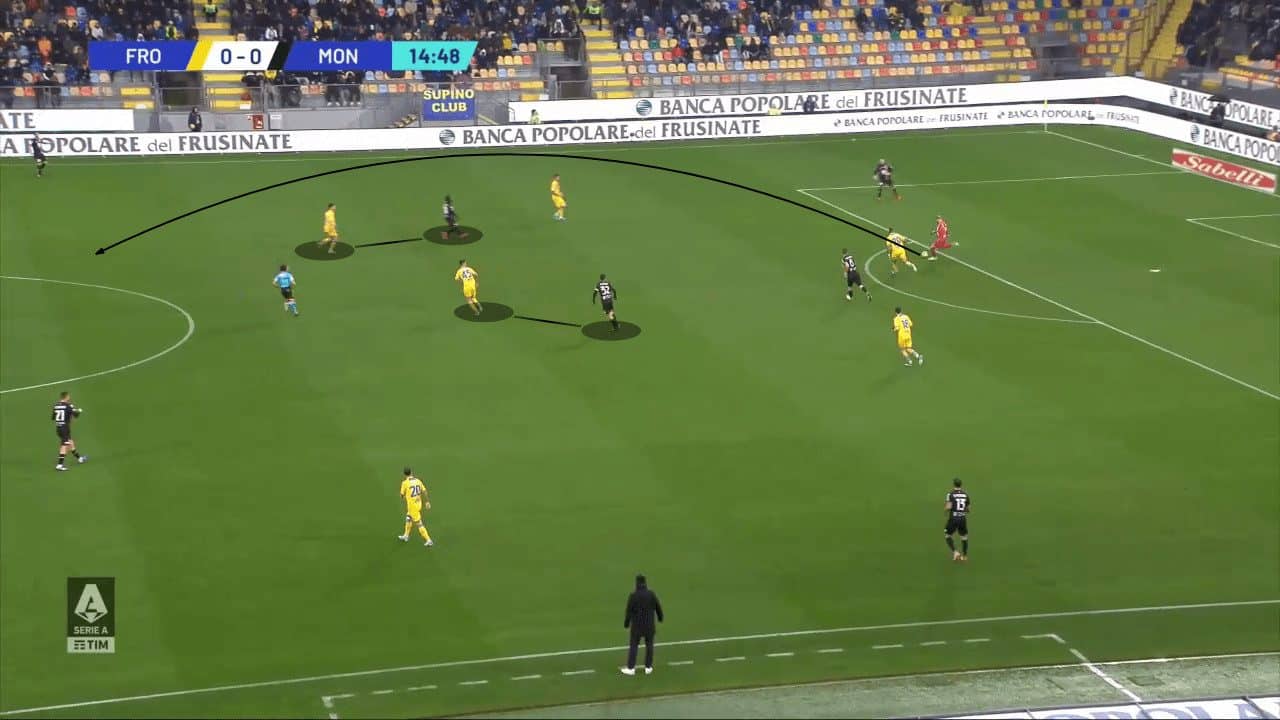
And Mota could receive.
However, most of these long balls were hard to control from one touch, and Monza couldn’t cause the same attacking threat as they used to.
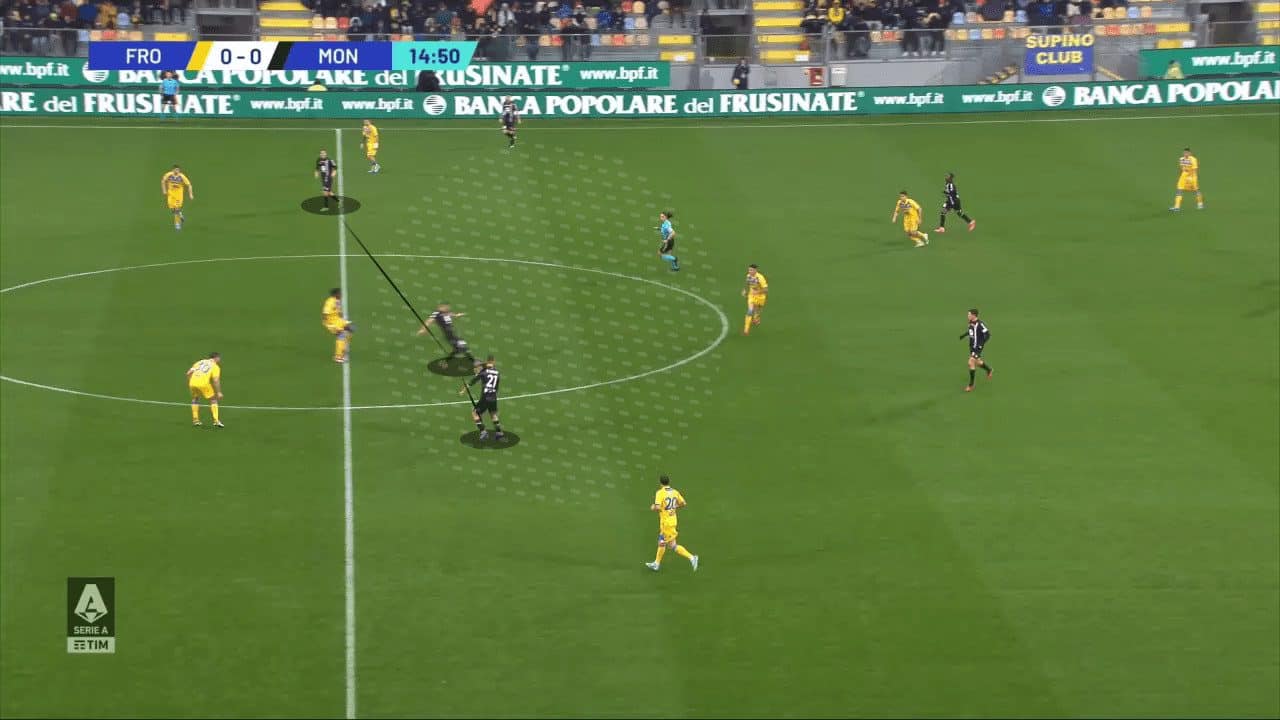
Pessina had space to receive during the second half, while Luca Mazzitelli immediately pressed him.

He succeeded in intercepting the ball with good anticipation to start an attacking transition.
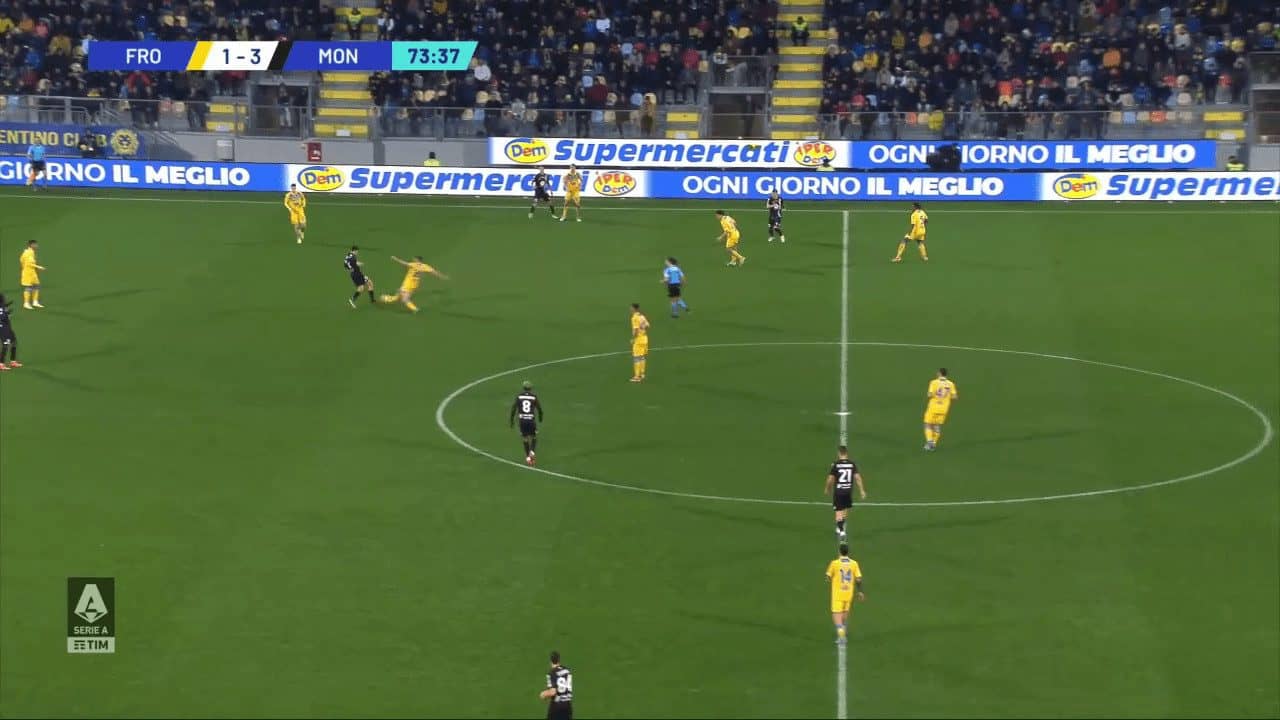
Then, he spotted the substitute Giuseppe Caso running in the space behind D’Ambrosio.
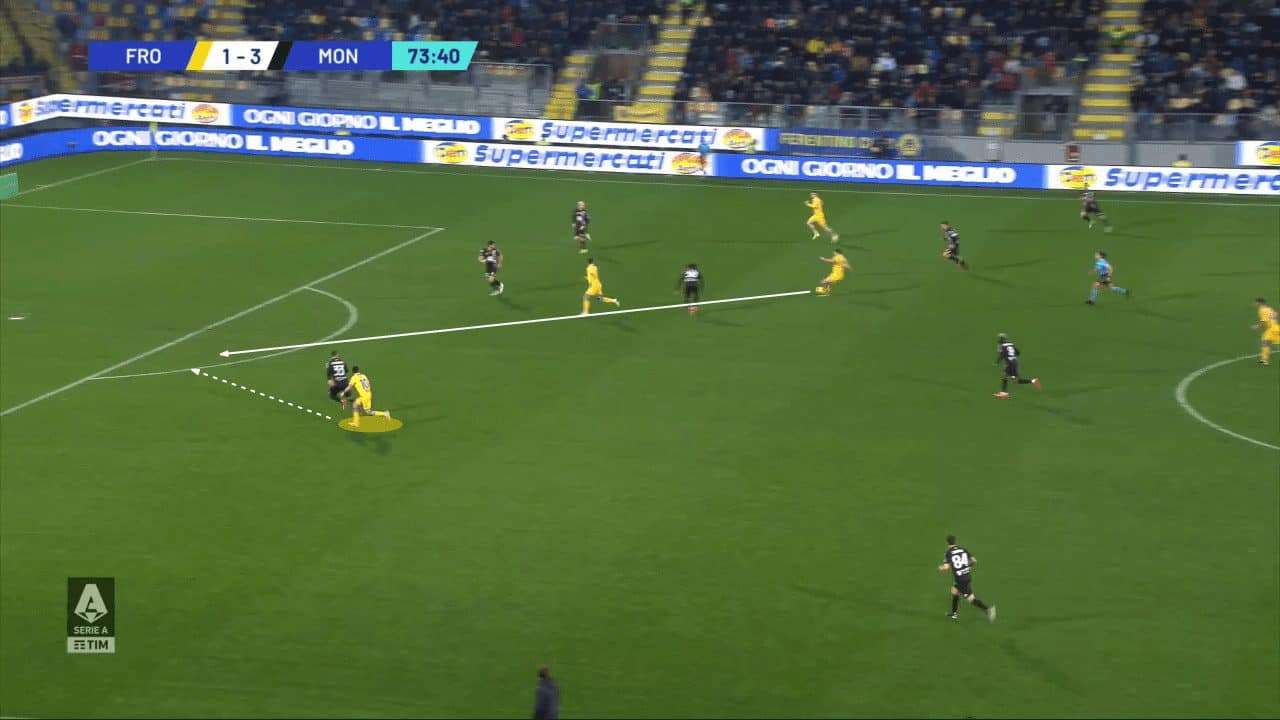
Playing a precise pass, Caso won a penalty for his team to score their second goal of the game.
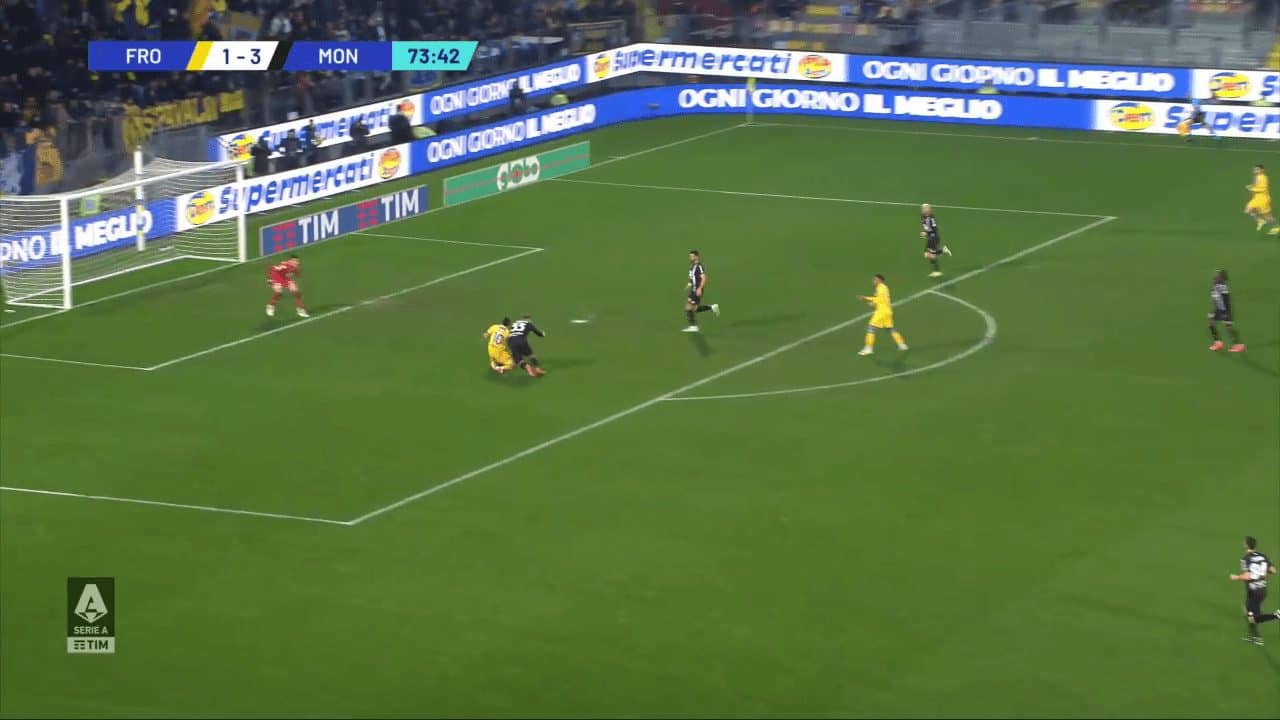
Conclusion
Monza have proven that they are one of the best Italian teams during the build-up phase. Their principles, variation and adaptability are outstanding when you remember it’s only their second-ever Serie A season.
In contrast, they suffered against Frosinone’s man-oriented approach despite winning the game, and it would be interesting to see how teams will learn from that game and operate the same idea.
More exciting is how Palladino’s side will adapt to playing against that approach; they showed they can adapt and get even better at that phase.

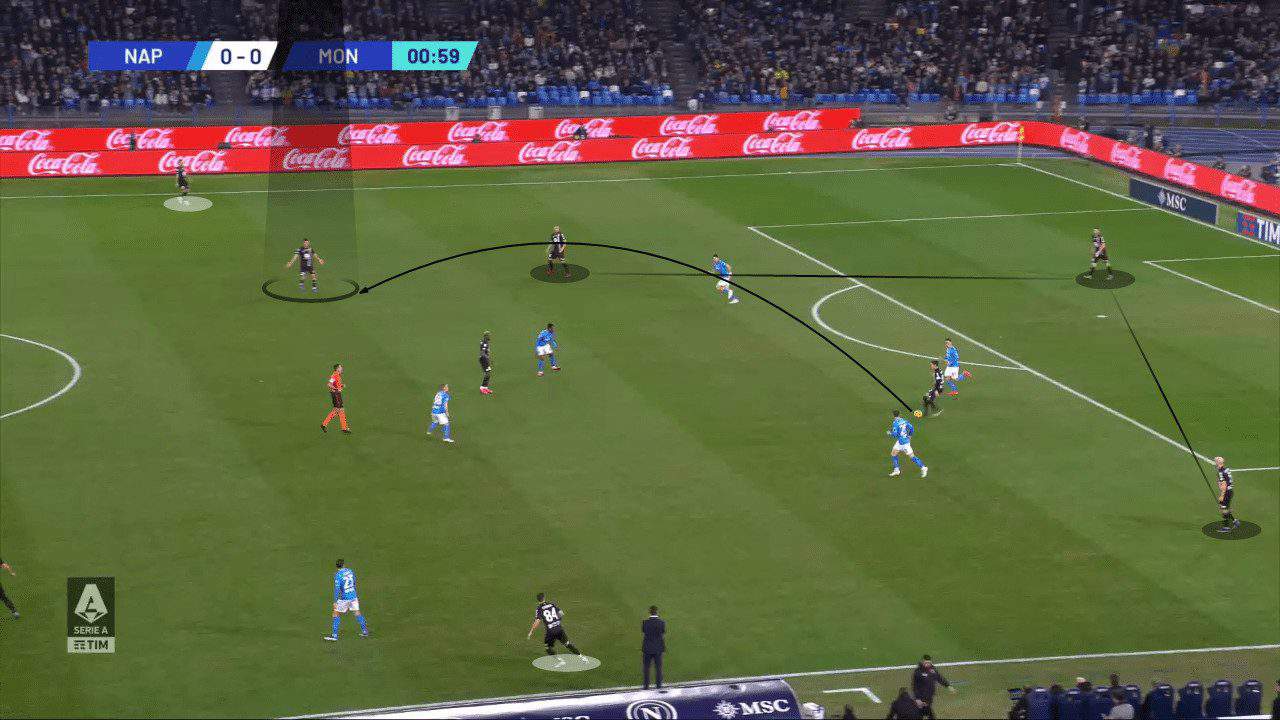



Comments